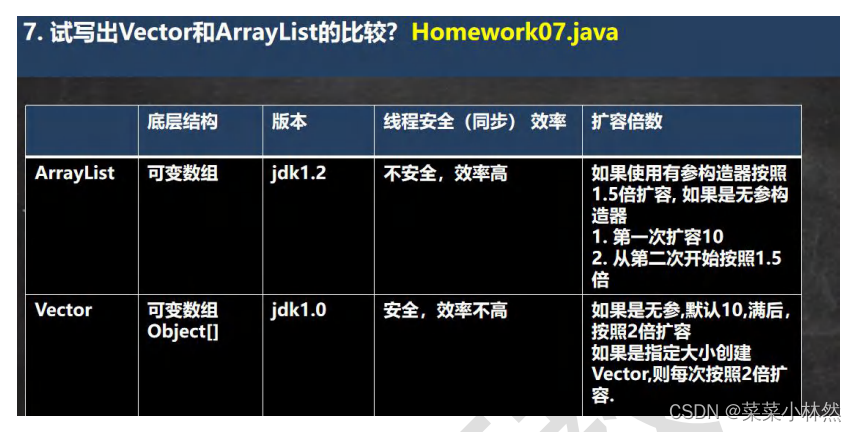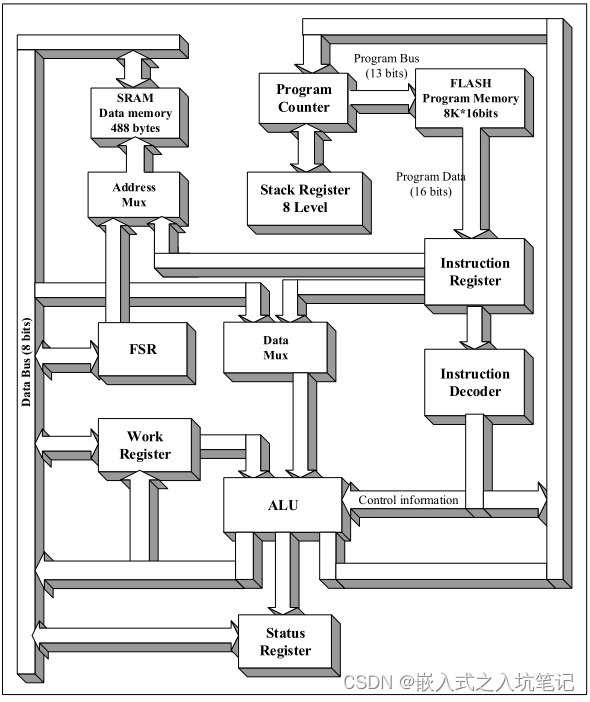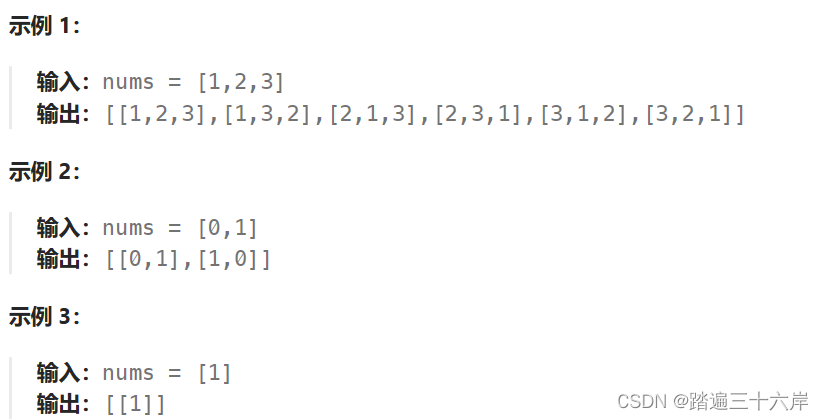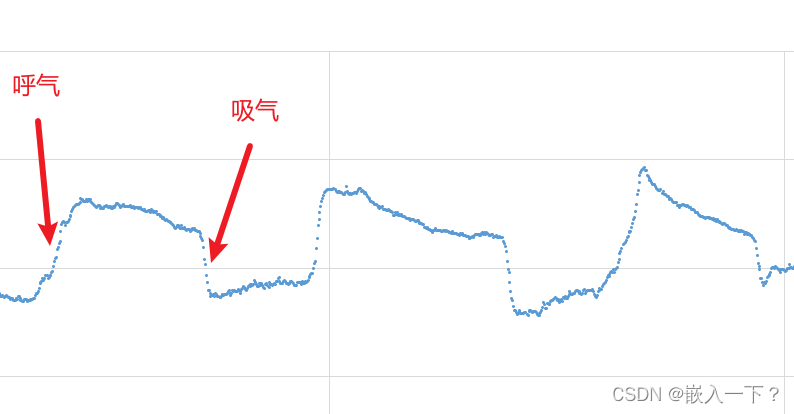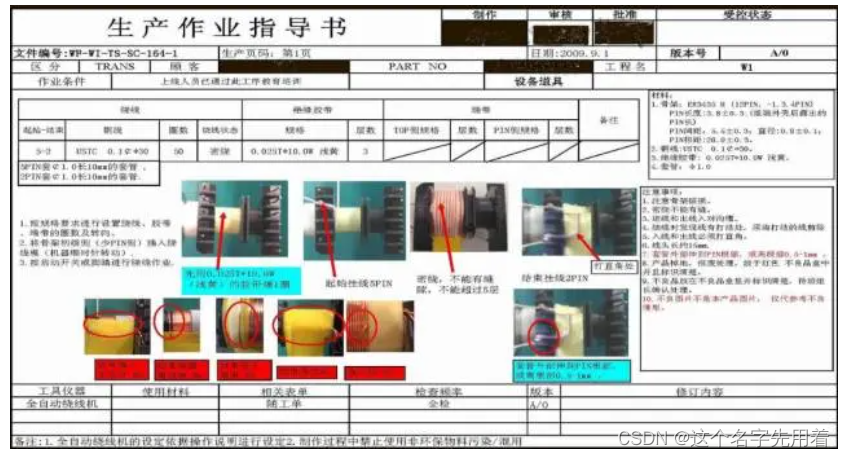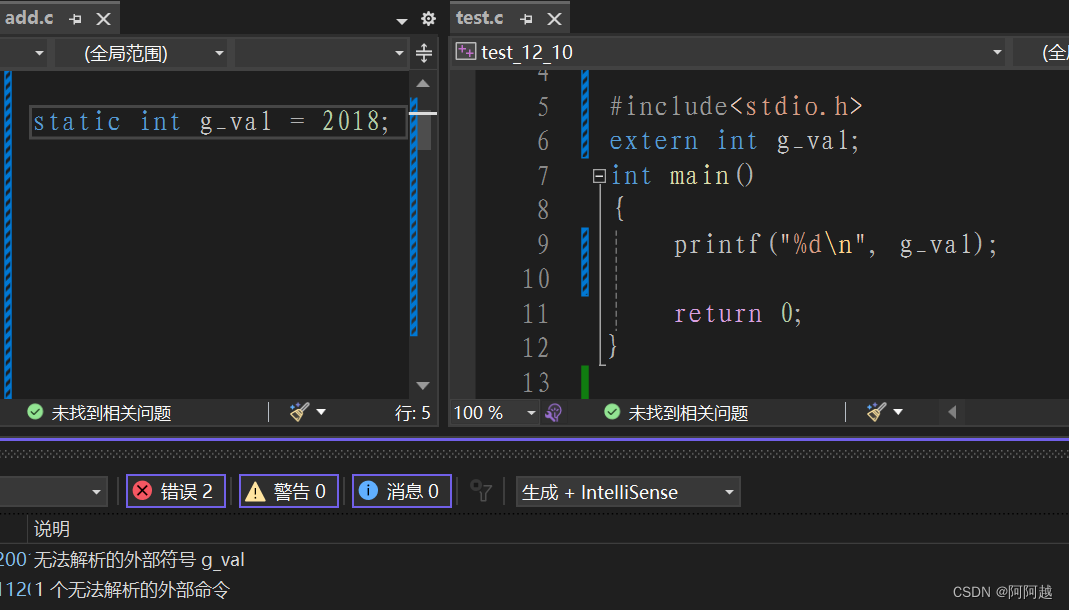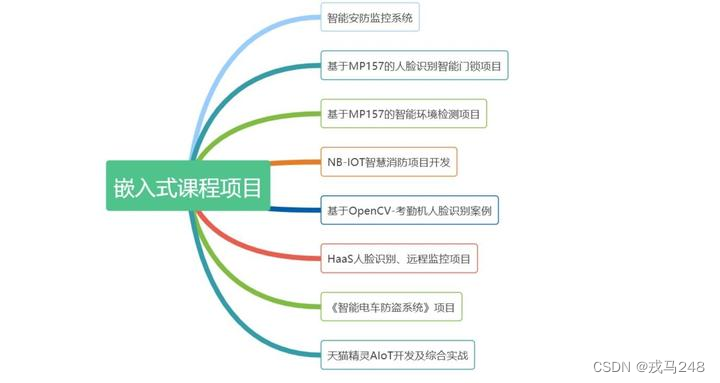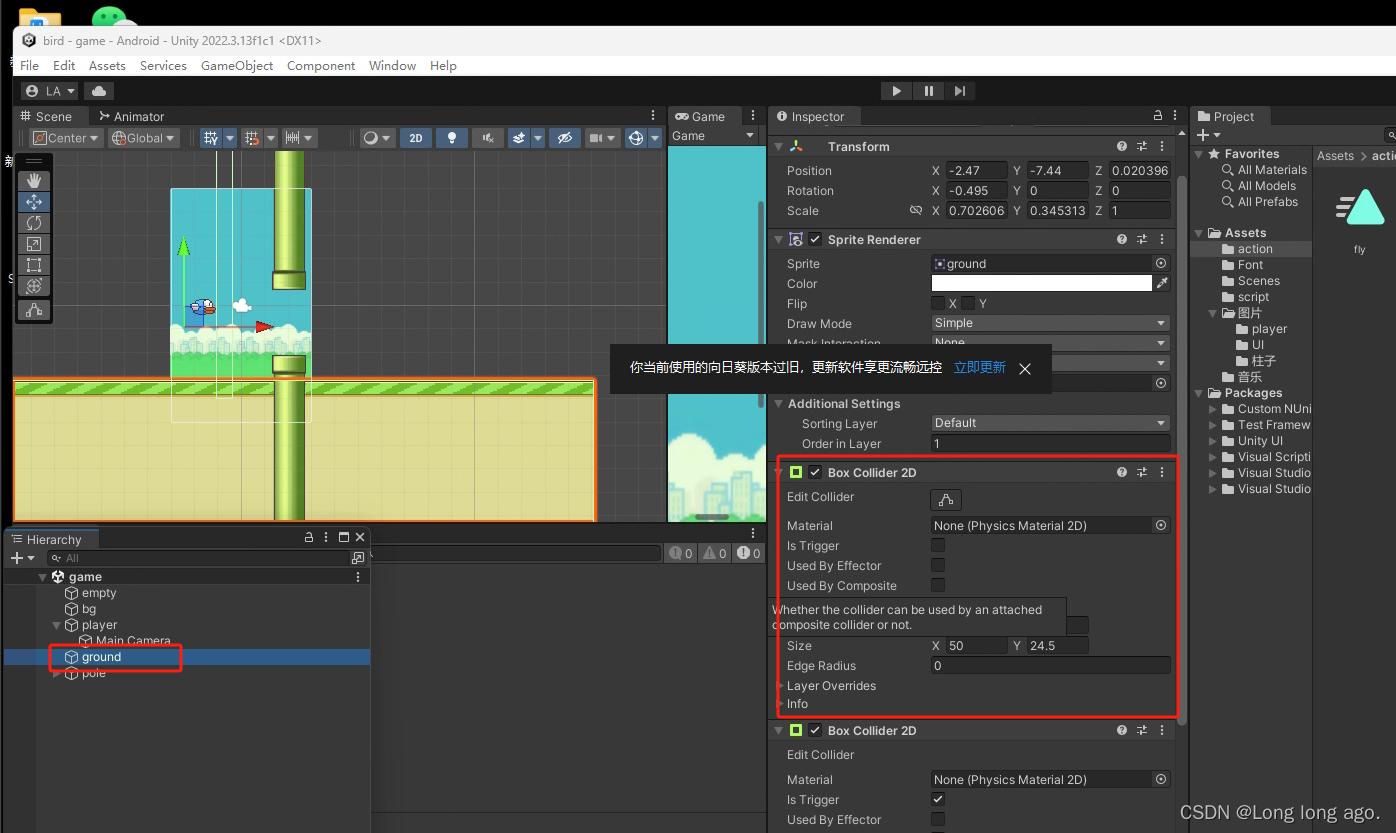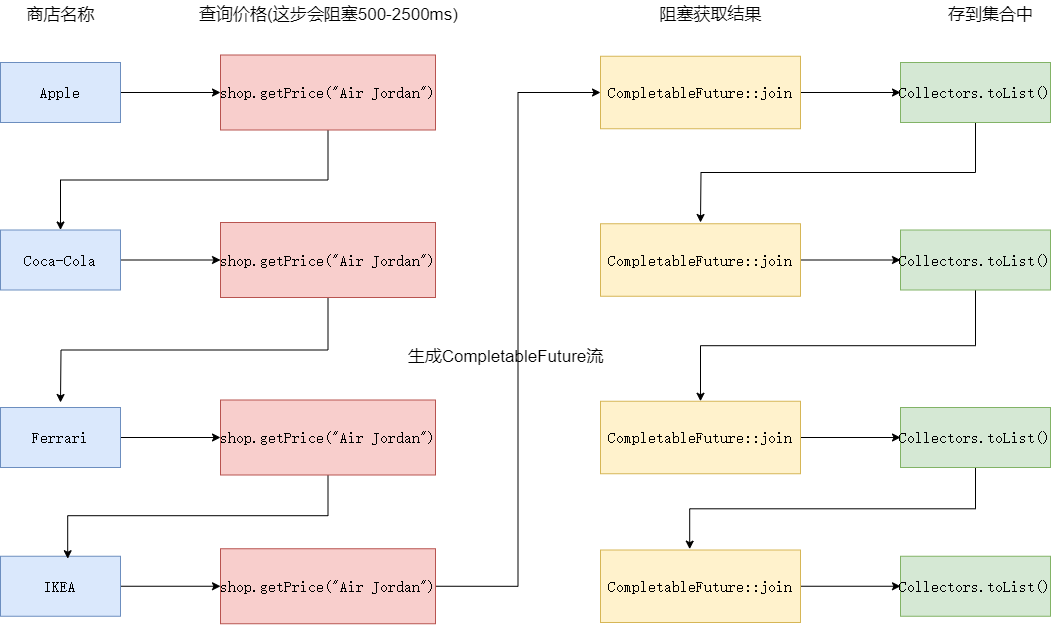一、集合
前面我们保存多个数据使用的是数组,那么数组有不足的地方,我们分析一下
1.数组
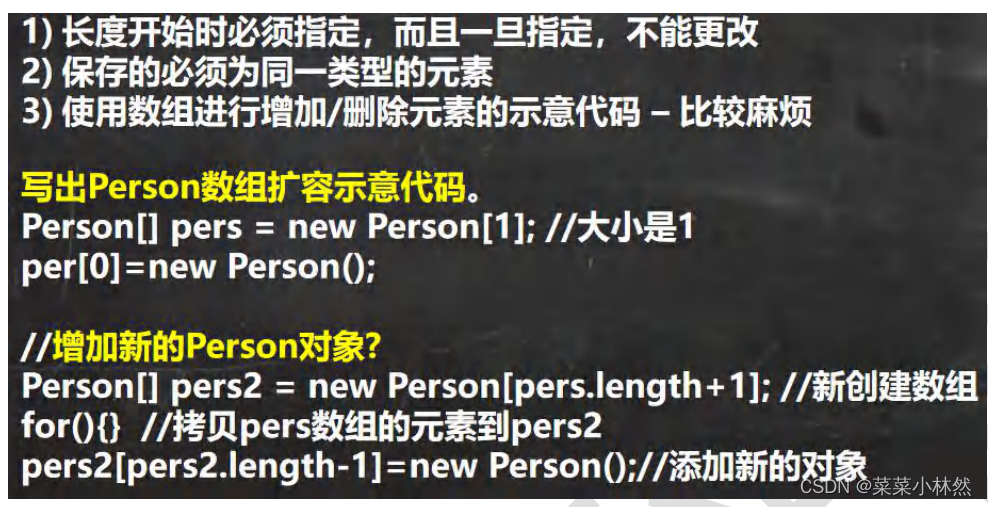
2 集合
- 数据类型也可以不一样

3.集合的框架体系
- Java 的集合类很多,主要分为两大类,如图 :[背下来]
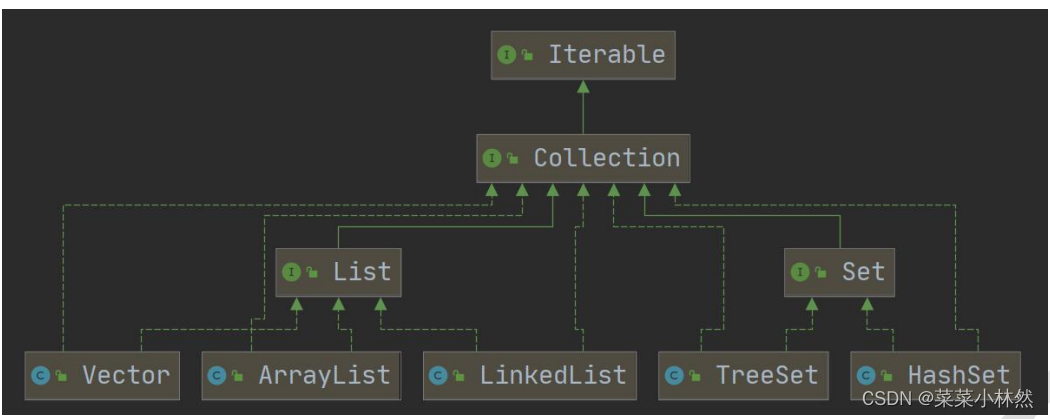
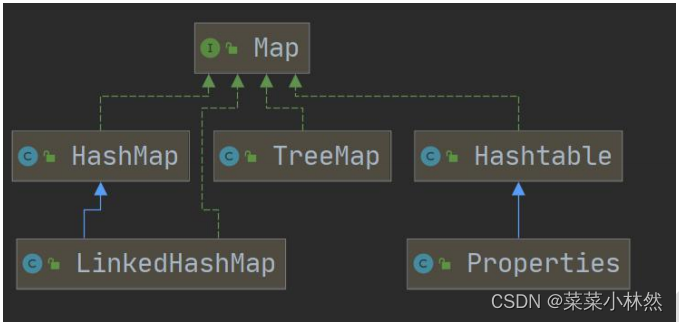
package com.hspedu.collection_;
import java.util.ArrayList;
import java.util.Collection;
import java.util.HashMap;
/**
* @author 林然
* @version 1.0
*/
public class Collection_ {
public static void main(String[] args) {
//1. 集合主要是两组(单列集合 , 双列集合)
//2. Collection 接口有两个重要的子接口 List 和Set , 他们的实现子类都是单列集合
//3. Map 接口的实现子类 是双列集合,存放的 K-V
//4. 把老师梳理的两张图记住
ArrayList arrayList =new ArrayList();
arrayList.add("jack");
arrayList.add("tom");
HashMap hashMap =new HashMap();
hashMap.put("No1","北京");
}
}
4.Collection 接口和常用方法
4.1Collection 接口实现类的特点

- Collection 接口常用方法,以实现子类 ArrayList 来演示
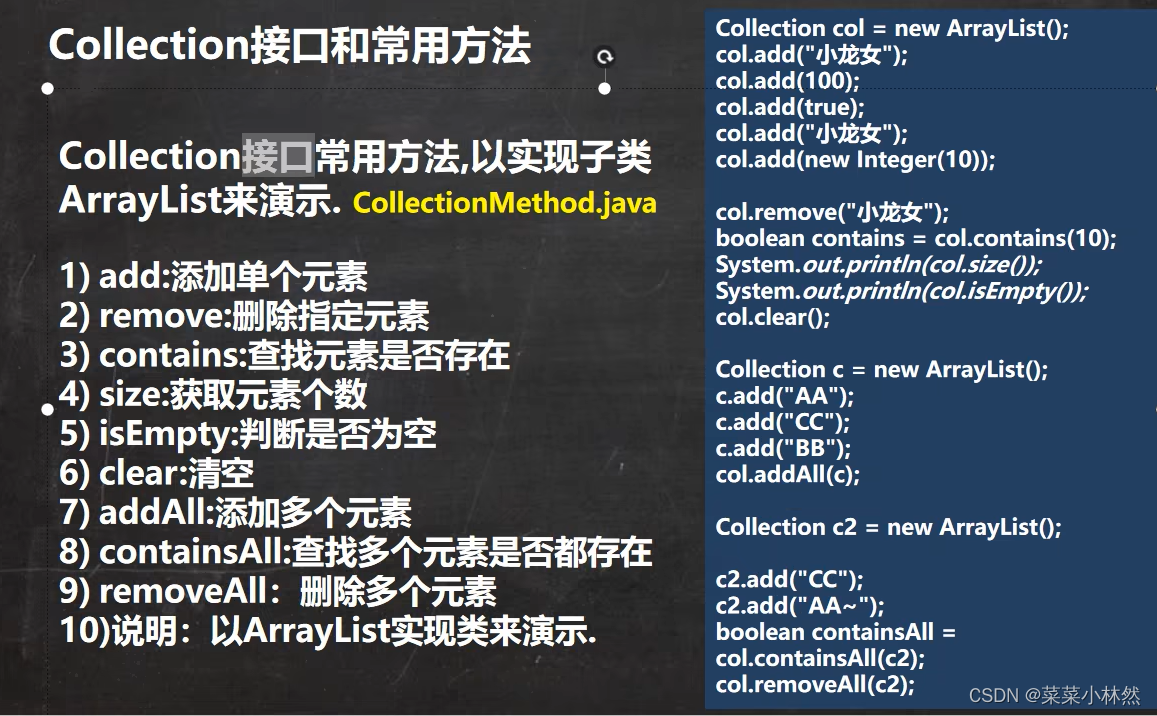
package com.hspedu.collection_;
import java.util.ArrayList;
import java.util.List;
/**
* @author 林然
* @version 1.0
*/
public class CollectionMethod {
@SuppressWarnings("all")
public static void main(String[] args) {
List list =new ArrayList();
// add:添加单个元素
list.add("jack");
list.add(10);//这里相当于自动装箱了,添加的实际是对象
list.add(true);
System.out.println("list="+list);
// remove:删除指定元素
//list.remove(0);//删除第一个元素
list.remove(true);//指定删除某个元素
System.out.println("list=" + list);
// contains:查找元素是否存在
System.out.println(list.contains("jack"));//T
// size:获取元素个数
System.out.println(list.size());//2
// isEmpty:判断是否为空
System.out.println(list.isEmpty());//F
// clear:清空
list.clear();
System.out.println("list=" + list);
// addAll:添加多个元素
ArrayList list2=new ArrayList();
list2.add("加油");
list2.add("java大神");
list.addAll(list2);
System.out.println("list=" + list);
// containsAll:查找多个元素是否都存在
System.out.println(list.containsAll(list2));//T
// removeAll:删除多个元素
list.add("聊斋");
list.removeAll(list2);
System.out.println("list=" + list);//[聊斋]
}
}
4.2 Collection 接口遍历元素方式 1-使用 Iterator(迭代器)
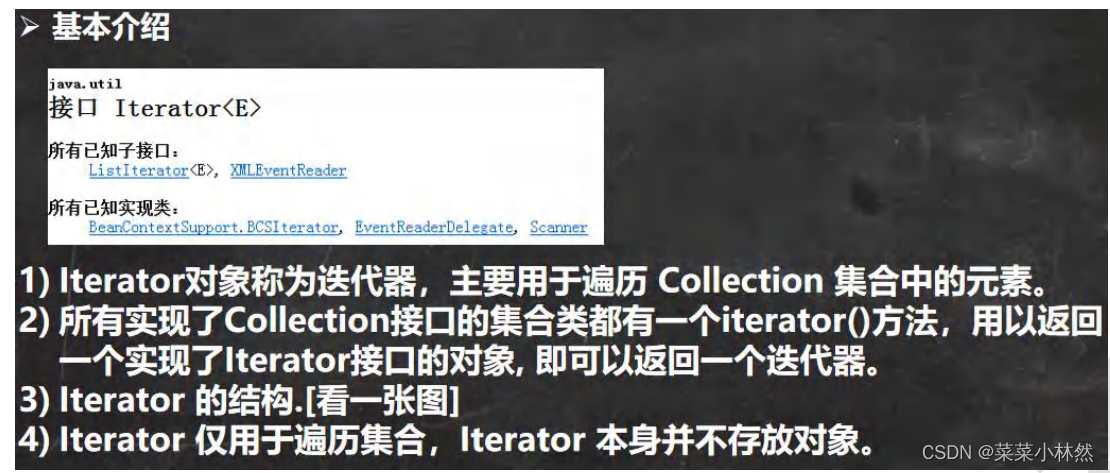


package com.hspedu.collection_;
import java.util.ArrayList;
import java.util.Collection;
import java.util.Iterator;
/**
* @author 林然
* @version 1.0
*/
@SuppressWarnings({"all"})
public class CollectionIterator {
public static void main(String[] args) {
Collection col = new ArrayList();
col.add(new Book1("三国演义", "罗贯中", 10.1));
col.add(new Book1("小李飞刀", "古龙", 5.1));
col.add(new Book1("红楼梦", "曹雪芹", 34.6));
//现在老师希望能够遍历 col 集合
//1. 先得到 col 对应的 迭代器
Iterator iterator =col.iterator();
//2. 使用 while 循环遍历
// while (iterator.hasNext()) {//判断是否还有数据
// //返回下一个元素,类型是 Object
// Object obj = iterator.next();
// System.out.println("obj=" + obj);
// }
//教大家一个快捷键,快速生成 while => itit
//显示所有的快捷键的的快捷键 ctrl + j
while (iterator.hasNext()) {
Object next = iterator.next();
System.out.println(next);
}
//3. 当退出 while 循环后 , 这时 iterator 迭代器,指向最后的元素
// iterator.next();//NoSuchElementException
//4. 如果希望再次遍历,需要重置我们的迭代器
iterator = col.iterator();
System.out.println("===第二次遍历===");
while (iterator.hasNext()) {
Object obj = iterator.next();
System.out.println("obj=" + obj);
}
}
}
@SuppressWarnings({"all"})
class Book1 {
private String name;
private String author;
private double price;
public Book1(String name, String author, double price) {
this.name = name;
this.author = author;
this.price = price;
}
@Override
public String toString() {
return "Book1{" +
"name='" + name + '\'' +
", author='" + author + '\'' +
", price=" + price +
'}';
}
}4.3 Collection 接口遍历对象方式 2-for 循环增强

package com.hspedu.collection_;
import java.util.ArrayList;
import java.util.Collection;
/**
* @author 林然
* @version 1.0
*/
public class CollectionFor {
@SuppressWarnings("all")
public static void main(String[] args) {
Collection col = new ArrayList();
col.add(new Book1("三国演义", "罗贯中", 10.1));
col.add(new Book1("小李飞刀", "古龙", 5.1));
col.add(new Book1("红楼梦", "曹雪芹", 34.6));
//使用增强for循环
for(Object k:col){
System.out.println("book="+k);
}
}
}
4.4 课堂练习

package com.hspedu.collection_;
import java.util.ArrayList;
import java.util.Iterator;
import java.util.List;
public class CollectionExercise {
@SuppressWarnings({"all"})
public static void main(String[] args) {
List list = new ArrayList();
list.add(new Dog("小黑", 3));
list.add(new Dog("大黄", 100));
list.add(new Dog("大壮", 8));
//先使用for增强
for (Object dog : list) {
System.out.println("dog=" + dog);
}
//使用迭代器
System.out.println("===使用迭代器来遍历===");
Iterator iterator = list.iterator();
while (iterator.hasNext()) {
Object dog = iterator.next();
System.out.println("dog=" + dog);
}
}
}
/**
* 创建 3个 Dog {name, age} 对象,放入到 ArrayList 中,赋给 List 引用
* 用迭代器和增强for循环两种方式来遍历
* 重写Dog 的toString方法, 输出name和age
*/
class Dog {
private String name;
private int age;
public Dog(String name, int age) {
this.name = name;
this.age = age;
}
public String getName() {
return name;
}
public void setName(String name) {
this.name = name;
}
public int getAge() {
return age;
}
public void setAge(int age) {
this.age = age;
}
@Override
public String toString() {
return "Dog{" +
"name='" + name + '\'' +
", age=" + age +
'}';
}
}
二、List
1.List 接口和常用方法
1.1 List 接口基本介绍
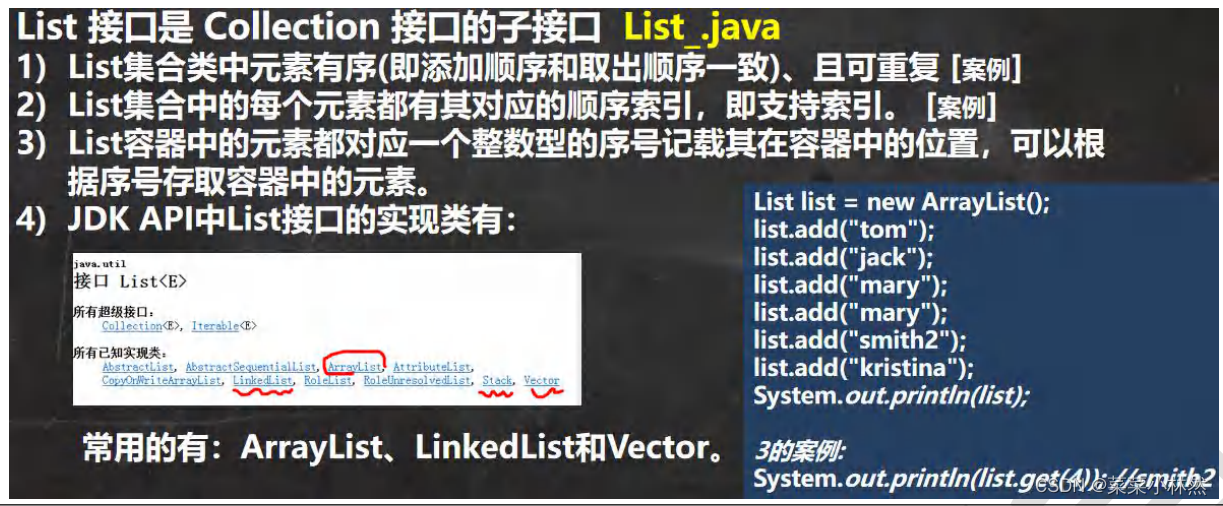
package com.hspedu.list_;
import java.util.ArrayList;
import java.util.List;
/**
* @author 林然
* @version 1.0
*/
public class List_ {
@SuppressWarnings("all")
public static void main(String[] args) {
//1. List 集合类中元素有序(即添加顺序和取出顺序一致)、且可重复 [案例]
List list = new ArrayList();
list.add("jack");
list.add("tom");
list.add("mary");
list.add("lsl");
list.add("tom");
System.out.println("list=" + list);
//2. List 集合中的每个元素都有其对应的顺序索引,即支持索引
// 索引是从 0 开始的
System.out.println(list.get(3));//lsl
//3
}
}
1.2 List 接口的常用方法
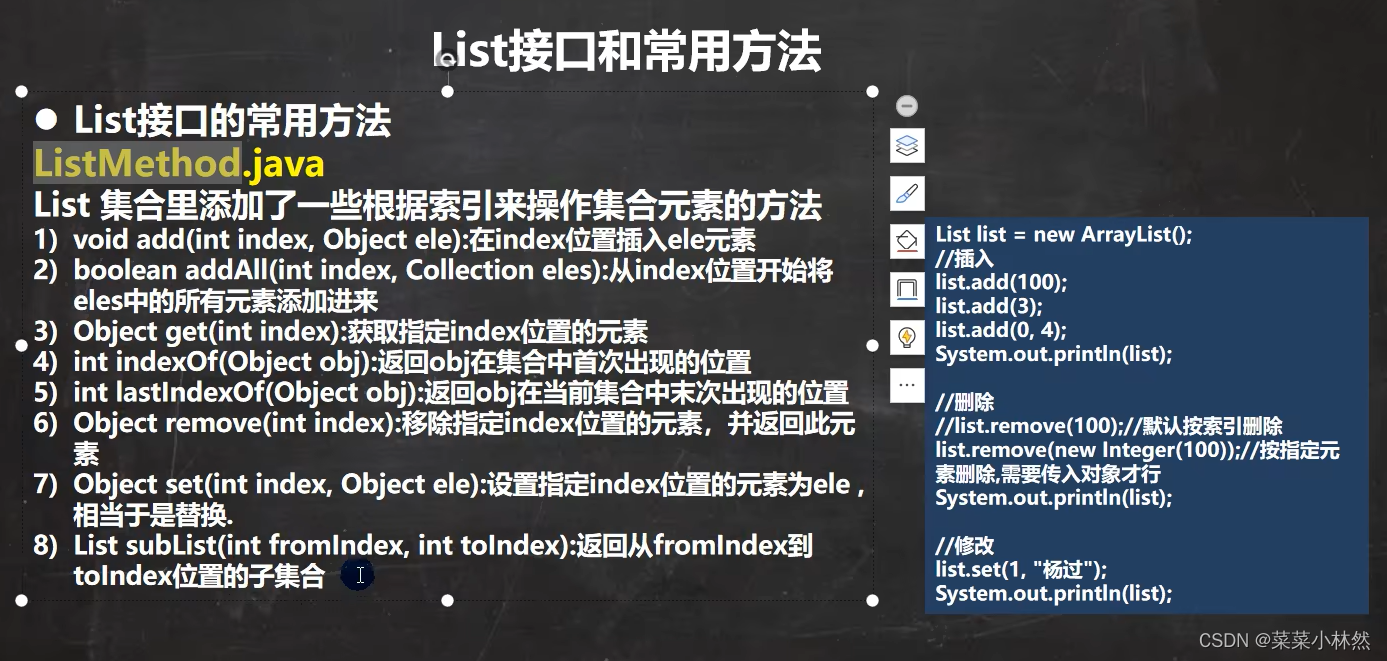
package com.hspedu.list_;
import java.util.ArrayList;
import java.util.List;
/**
* @author 林然
* @version 1.0
*/
public class ListMethod {
@SuppressWarnings("all")
public static void main(String[] args) {
List list =new ArrayList();
list.add("张三丰");
list.add("贾宝玉");
// void add(int index, Object ele):在 index 位置插入 ele 元素
//在 index = 1 的位置插入一个对象
list.add(1, "林然");
System.out.println("list=" + list);
// boolean addAll(int index, Collection eles):从 index 位置开始将 eles 中的所有元素添加进来
List list2 = new ArrayList();
list2.add("jack");
list2.add("tom");
list.addAll(1, list2);
System.out.println("list=" + list);
// Object get(int index):获取指定 index 位置的元素
// int indexOf(Object obj):返回 obj 在集合中首次出现的位置
System.out.println(list.indexOf("tom"));//2
// int lastIndexOf(Object obj):返回 obj 在当前集合中末次出现的位置
list.add("林然");
System.out.println("list=" + list);
System.out.println(list.lastIndexOf("林然"));
// Object remove(int index):移除指定 index 位置的元素,并返回此元素
list.remove(0);
System.out.println("list=" + list);
// Object set(int index, Object ele):设置指定 index 位置的元素为 ele , 相当于是替换. list.set(1, "玛丽");
System.out.println("list=" + list);
// List subList(int fromIndex, int toIndex):返回从 fromIndex 到 toIndex 位置的子集合
// 注意返回的子集合 fromIndex <= subList < toIndex
List returnlist = list.subList(0, 2);
System.out.println("returnlist=" + returnlist);
}
}
1.3 List 接口课堂练习

package com.hspedu.list_;
import java.util.ArrayList;
import java.util.Iterator;
import java.util.List;
public class ListExercise {
@SuppressWarnings({"all"})
public static void main(String[] args) {
/*
添加10个以上的元素(比如String "hello" ),在2号位插入一个元素"韩顺平教育",
获得第5个元素,删除第6个元素,修改第7个元素,在使用迭代器遍历集合,
要求:使用List的实现类ArrayList完成。
*/
List list = new ArrayList();
for (int i = 0; i < 12; i++) {
list.add("hello" + i);
}
System.out.println("list=" + list);
//在2号位插入一个元素"韩顺平教育"
list.add(1, "韩顺平教育");
System.out.println("list=" + list);
//获得第5个元素
System.out.println("第五个元素=" + list.get(4));
//删除第6个元素
list.remove(5);
System.out.println("list=" + list);
//修改第7个元素
list.set(6, "三国演义");
System.out.println("list=" + list);
//在使用迭代器遍历集合
Iterator iterator = list.iterator();
while (iterator.hasNext()) {
Object obj = iterator.next();
System.out.println("obj=" + obj);
}
}
}
1.4 List 的三种遍历方式 [ArrayList, LinkedList,Vector]
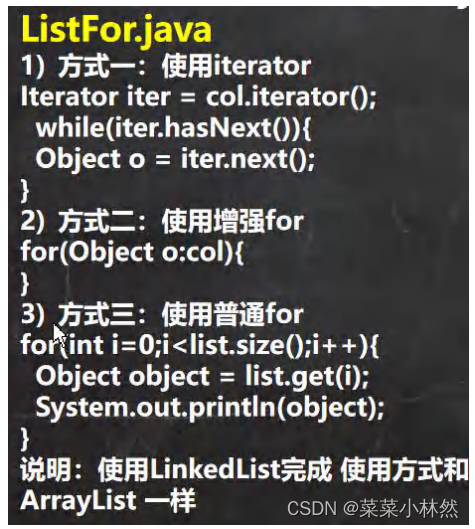
package com.hspedu.list_;
import java.util.*;
public class ListFor {
@SuppressWarnings({"all"})
public static void main(String[] args) {
//List 接口的实现子类 Vector LinkedList
//List list = new ArrayList();
//List list = new Vector();
List list = new LinkedList();
list.add("jack");
list.add("tom");
list.add("鱼香肉丝");
list.add("北京烤鸭子");
//遍历
//1. 迭代器
Iterator iterator = list.iterator();
while (iterator.hasNext()) {
Object obj = iterator.next();
System.out.println(obj);
}
System.out.println("=====增强for=====");
//2. 增强for
for (Object o : list) {
System.out.println("o=" + o);
}
System.out.println("=====普通for====");
//3. 使用普通for
for (int i = 0; i < list.size(); i++) {
System.out.println("对象=" + list.get(i));
}
}
}
1.5 实现类的课堂练习 2
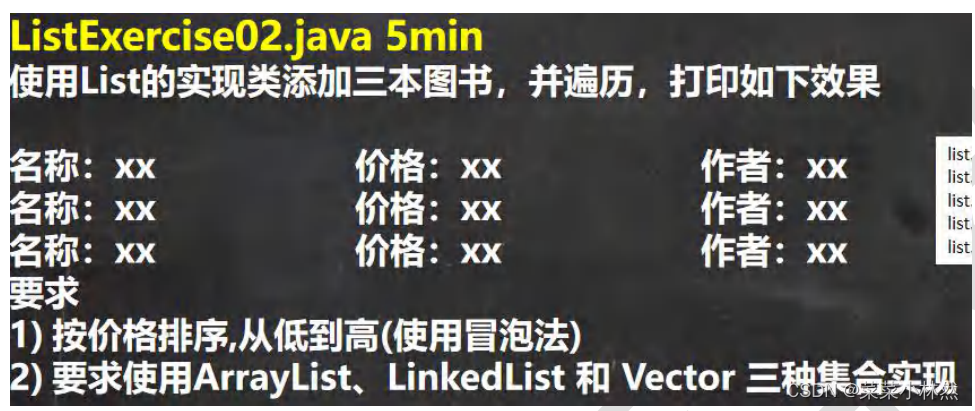
package com.hspedu.list_;
import java.util.ArrayList;
import java.util.LinkedList;
import java.util.List;
import java.util.Vector;
@SuppressWarnings({"all"})
public class ListExercise02 {
public static void main(String[] args) {
//List list = new ArrayList();
List list = new LinkedList();
//List list = new Vector();
list.add(new Book("红楼梦", "曹雪芹", 100));
list.add(new Book("西游记", "吴承恩", 10));
list.add(new Book("水浒传", "施耐庵", 19));
list.add(new Book("三国", "罗贯中", 80));
//list.add(new Book("西游记", "吴承恩", 10));
//如何对集合进行排序
//遍历
for (Object o : list) {
System.out.println(o);
}
//冒泡排序
sort(list);
System.out.println("==排序后==");
for (Object o : list) {
System.out.println(o);
}
}
//静态方法
//价格要求是从小到大
public static void sort(List list) {
int listSize = list.size();
for (int i = 0; i < listSize - 1; i++) {
for (int j = 0; j < listSize - 1 - i; j++) {
//取出对象Book
Book book1 = (Book) list.get(j);
Book book2 = (Book) list.get(j + 1);
if (book1.getPrice() > book2.getPrice()) {//交换
list.set(j, book2);
list.set(j + 1, book1);
}
}
}
}
}
package com.hspedu.list_;
public class Book {
private String name;
private String author;
private double price;
public Book(String name, String author, double price) {
this.name = name;
this.author = author;
this.price = price;
}
public String getName() {
return name;
}
public void setName(String name) {
this.name = name;
}
public String getAuthor() {
return author;
}
public void setAuthor(String author) {
this.author = author;
}
public double getPrice() {
return price;
}
public void setPrice(double price) {
this.price = price;
}
@Override
public String toString() {
return "名称:" + name + "\t\t价格:" + price + "\t\t作者:" + author;
}
}
2.ArrayList 底层结构和源码分析
2.1 ArrayList 的注意事项

2.2 ArrayList 的底层操作机制源码分析(重点,难点.)
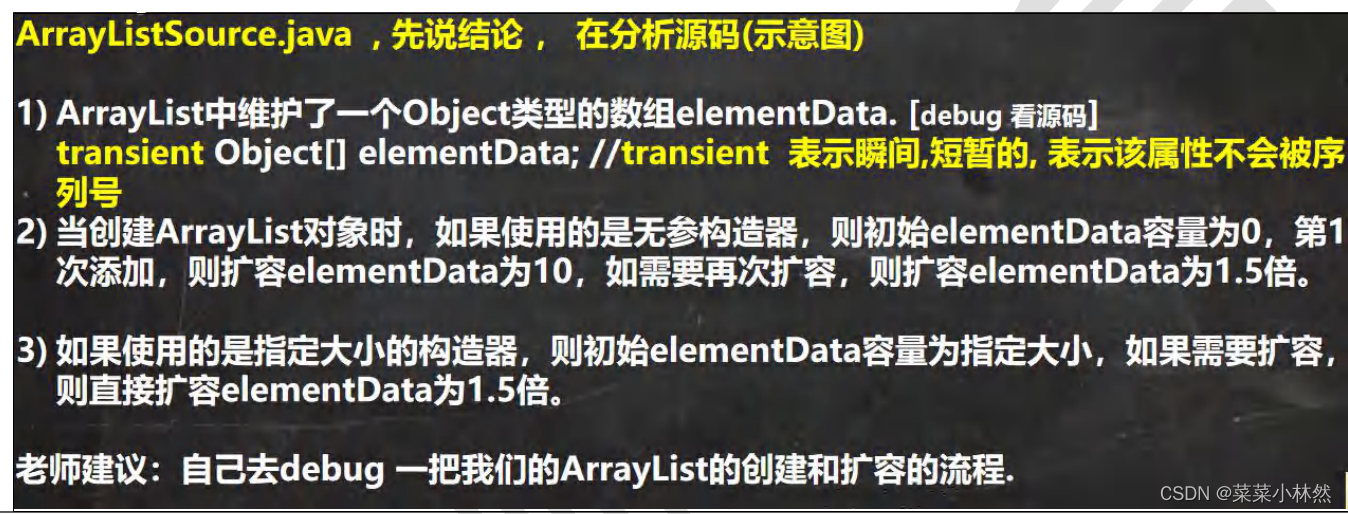
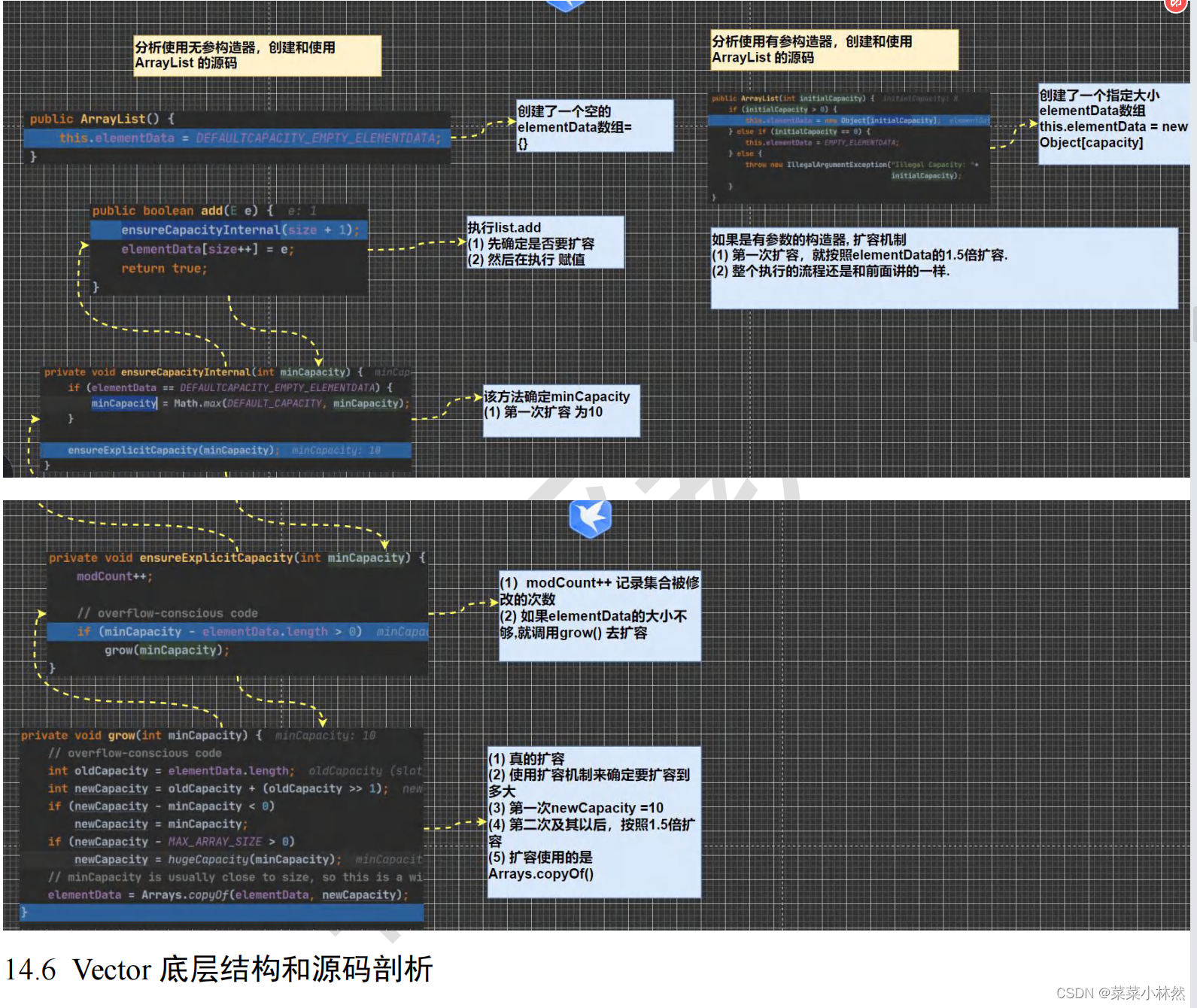 3.Vector 底层结构和源码剖析
3.Vector 底层结构和源码剖析
3.1 Vector 的基本介绍

3.2 Vector 和 ArrayList 的比较
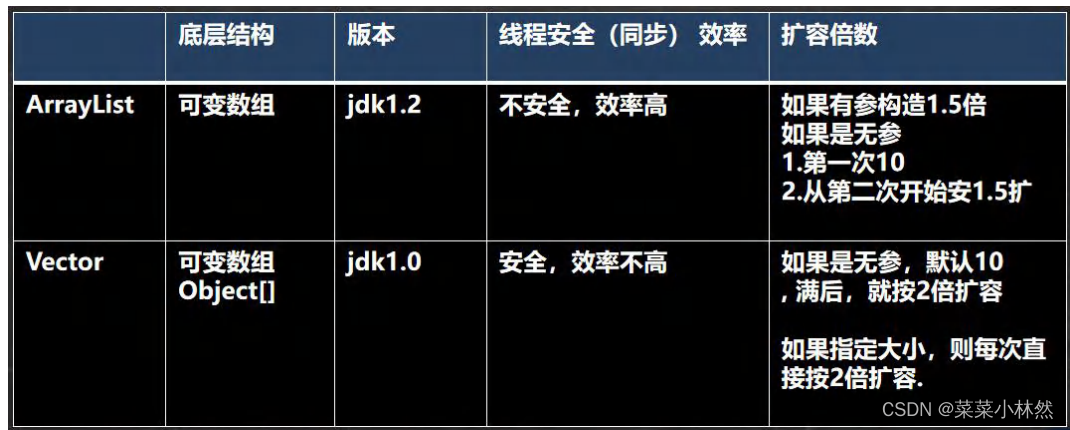
4.LinkedList 底层结构
4.1 LinkedList 的全面说明

4.2 LinkedList 的底层操作机制
【这里其实就是涉及数据结构的知识点】
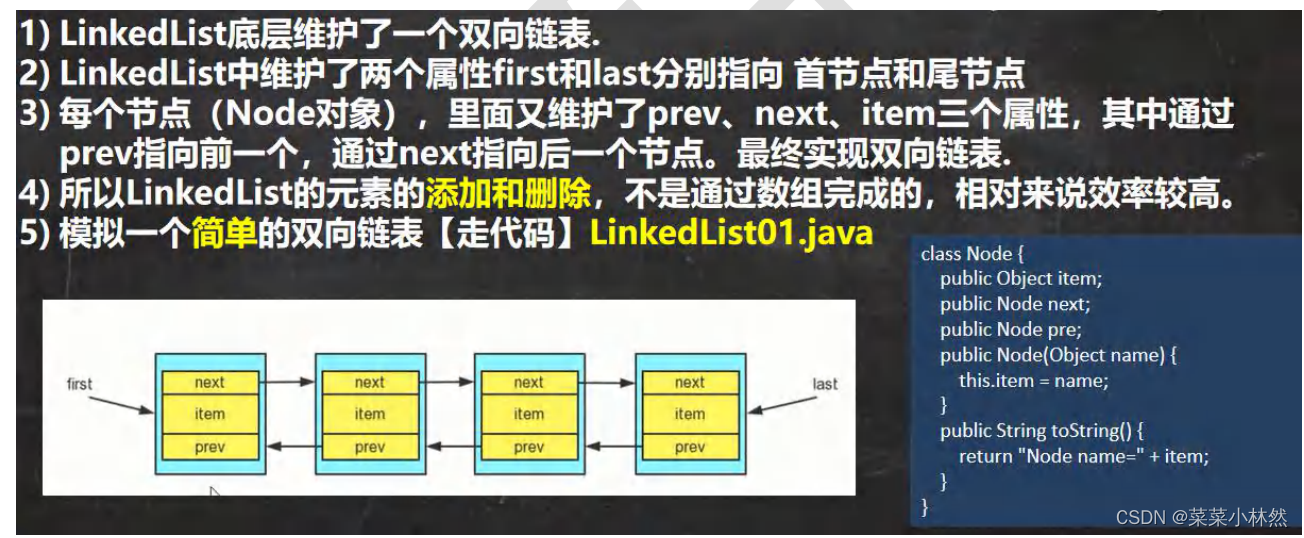
package com.hspedu.list_;
public class LinkedList01 {
public static void main(String[] args) {
//模拟一个简单的双向链表
Node jack = new Node("jack");
Node tom = new Node("tom");
Node hsp = new Node("老韩");
//连接三个结点,形成双向链表
//jack -> tom -> hsp
jack.next = tom;
tom.next = hsp;
//hsp -> tom -> jack
hsp.pre = tom;
tom.pre = jack;
Node first = jack;//让first引用指向jack,就是双向链表的头结点
Node last = hsp; //让last引用指向hsp,就是双向链表的尾结点
//演示,从头到尾进行遍历
System.out.println("===从头到尾进行遍历===");
while (true) {
if(first == null) {
break;
}
//输出first 信息
System.out.println(first);
first = first.next;
}
//演示,从尾到头的遍历
System.out.println("====从尾到头的遍历====");
while (true) {
if(last == null) {
break;
}
//输出last 信息
System.out.println(last);
last = last.pre;
}
//演示链表的添加对象/数据,是多么的方便
//要求,是在 tom --------- 老韩直接,插入一个对象 smith
//1. 先创建一个 Node 结点,name 就是 smith
Node smith = new Node("smith");
//下面就把 smith 加入到双向链表了
smith.next = hsp;
smith.pre = tom;
hsp.pre = smith;
tom.next = smith;
//让first 再次指向jack
first = jack;//让first引用指向jack,就是双向链表的头结点
System.out.println("===从头到尾进行遍历===");
while (true) {
if(first == null) {
break;
}
//输出first 信息
System.out.println(first);
first = first.next;
}
last = hsp; //让last 重新指向最后一个结点
//演示,从尾到头的遍历
System.out.println("====从尾到头的遍历====");
while (true) {
if(last == null) {
break;
}
//输出last 信息
System.out.println(last);
last = last.pre;
}
}
}
//定义一个Node 类,Node 对象 表示双向链表的一个结点
class Node {
public Object item; //真正存放数据
public Node next; //指向后一个结点
public Node pre; //指向前一个结点
public Node(Object name) {
this.item = name;
}
public String toString() {
return "Node name=" + item;
}
}
4.3 LinkedList 的增删改查案例
package com.hspedu.list_;
import java.util.Iterator;
import java.util.LinkedList;
/**
* @author 韩顺平
* @version 1.0
*/
@SuppressWarnings({"all"})
public class LinkedListCRUD {
public static void main(String[] args) {
LinkedList linkedList = new LinkedList();
linkedList.add(1);
linkedList.add(2);
linkedList.add(3);
System.out.println("linkedList=" + linkedList);
//演示一个删除结点的
linkedList.remove(); // 这里默认删除的是第一个结点
//linkedList.remove(2);
System.out.println("linkedList=" + linkedList);
//修改某个结点对象
linkedList.set(1, 999);
System.out.println("linkedList=" + linkedList);
//得到某个结点对象
//get(1) 是得到双向链表的第二个对象
Object o = linkedList.get(1);
System.out.println(o);//999
//因为LinkedList 是 实现了List接口, 遍历方式
System.out.println("===LinkeList遍历迭代器====");
Iterator iterator = linkedList.iterator();
while (iterator.hasNext()) {
Object next = iterator.next();
System.out.println("next=" + next);
}
System.out.println("===LinkeList遍历增强for====");
for (Object o1 : linkedList) {
System.out.println("o1=" + o1);
}
System.out.println("===LinkeList遍历普通for====");
for (int i = 0; i < linkedList.size(); i++) {
System.out.println(linkedList.get(i));
}
//老韩源码阅读.
/* 1. LinkedList linkedList = new LinkedList();
public LinkedList() {}
2. 这时 linkeList 的属性 first = null last = null
3. 执行 添加
public boolean add(E e) {
linkLast(e);
return true;
}
4.将新的结点,加入到双向链表的最后
void linkLast(E e) {
final Node<E> l = last;
final Node<E> newNode = new Node<>(l, e, null);
last = newNode;
if (l == null)
first = newNode;
else
l.next = newNode;
size++;
modCount++;
}
*/
/*
老韩读源码 linkedList.remove(); // 这里默认删除的是第一个结点
1. 执行 removeFirst
public E remove() {
return removeFirst();
}
2. 执行
public E removeFirst() {
final Node<E> f = first;
if (f == null)
throw new NoSuchElementException();
return unlinkFirst(f);
}
3. 执行 unlinkFirst, 将 f 指向的双向链表的第一个结点拿掉
private E unlinkFirst(Node<E> f) {
// assert f == first && f != null;
final E element = f.item;
final Node<E> next = f.next;
f.item = null;
f.next = null; // help GC
first = next;
if (next == null)
last = null;
else
next.prev = null;
size--;
modCount++;
return element;
}
*/
}
}
4.4 ArrayList 和 LinkedList 比较
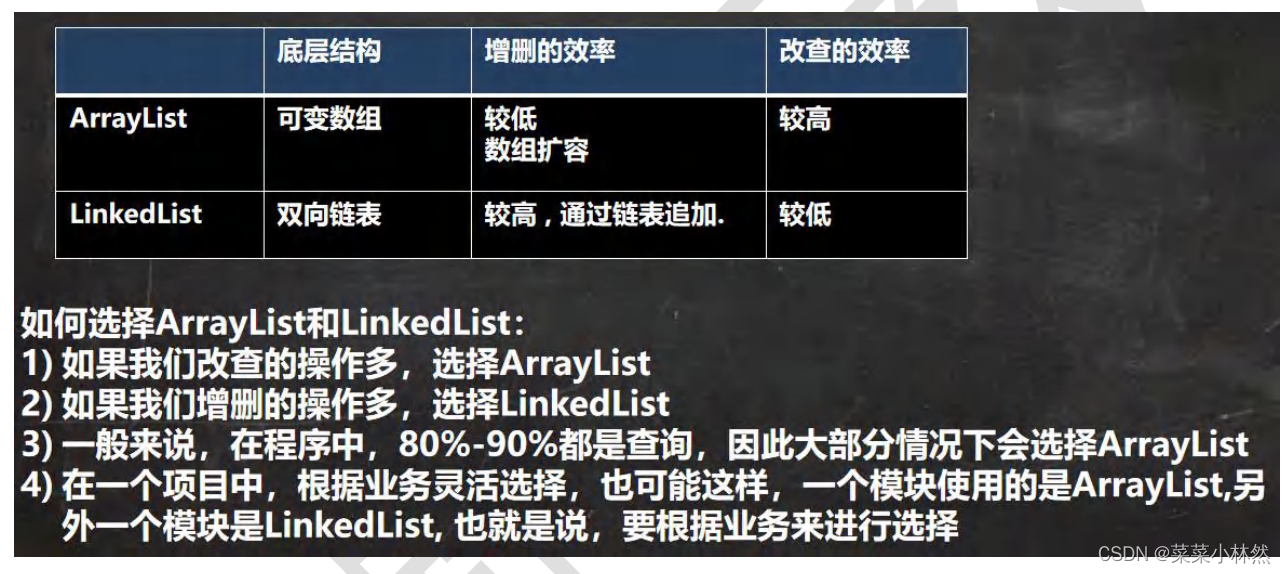
三、Set
1.Set 接口和常用方法
1.1 Set 接口基本介绍
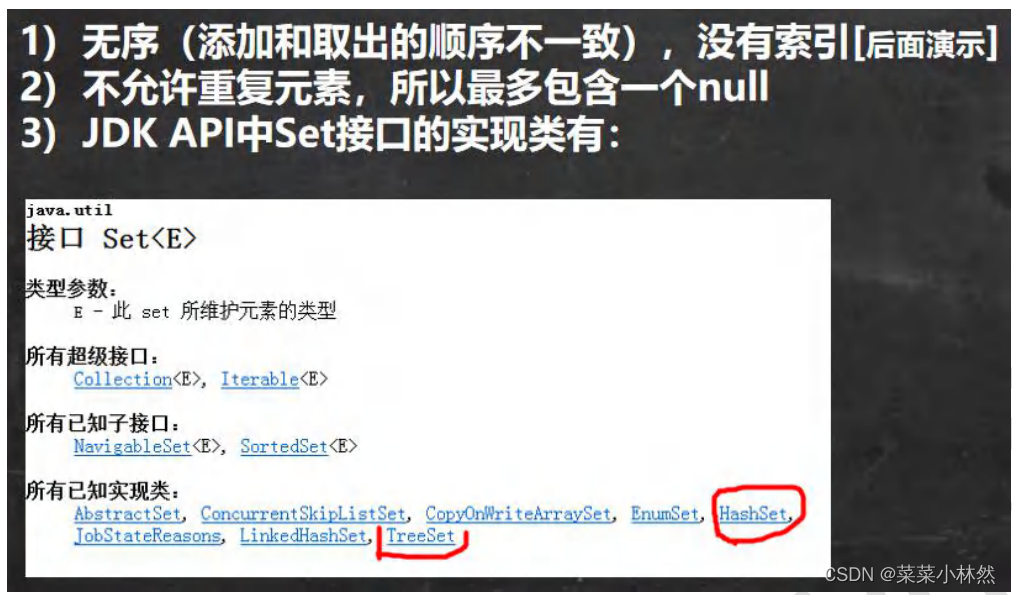
1.2 Set 接口的常用方法
和
List
接口一样
, Set
接口也是
Collection
的子接口,因此,常用方法和
Collection
接口一样
1.3 Set 接口的遍历方式

1.4 Set 接口的常用方法举例
package com.hspedu.set_;
import java.util.HashSet;
import java.util.Iterator;
import java.util.Set;
@SuppressWarnings({"all"})
public class SetMethod {
public static void main(String[] args) {
//老韩解读
//1. 以Set 接口的实现类 HashSet 来讲解Set 接口的方法
//2. set 接口的实现类的对象(Set接口对象), 不能存放重复的元素, 可以添加一个null
//3. set 接口对象存放数据是无序(即添加的顺序和取出的顺序不一致)
//4. 注意:取出的顺序的顺序虽然不是添加的顺序,但是他的固定【就是每次得到的顺序的固定的】.
Set set = new HashSet();
set.add("john");
set.add("lucy");
set.add("john");//重复,由于重复,只会有一个
set.add("jack");
set.add("hsp");
set.add("mary");
set.add(null);//
set.add(null);//再次添加null,由于重复,只会有一个
for(int i = 0; i <10;i ++) {
System.out.println("set=" + set);
}
//遍历
//方式1: 使用迭代器
System.out.println("=====使用迭代器====");
Iterator iterator = set.iterator();
while (iterator.hasNext()) {
Object obj = iterator.next();
System.out.println("obj=" + obj);
}
set.remove(null);
//方式2: 增强for
System.out.println("=====增强for====");
for (Object o : set) {
System.out.println("o=" + o);
}
//set 接口对象,不能通过索引来获取
}
}
2.HashSet
2.1 HashSet 的全面说明
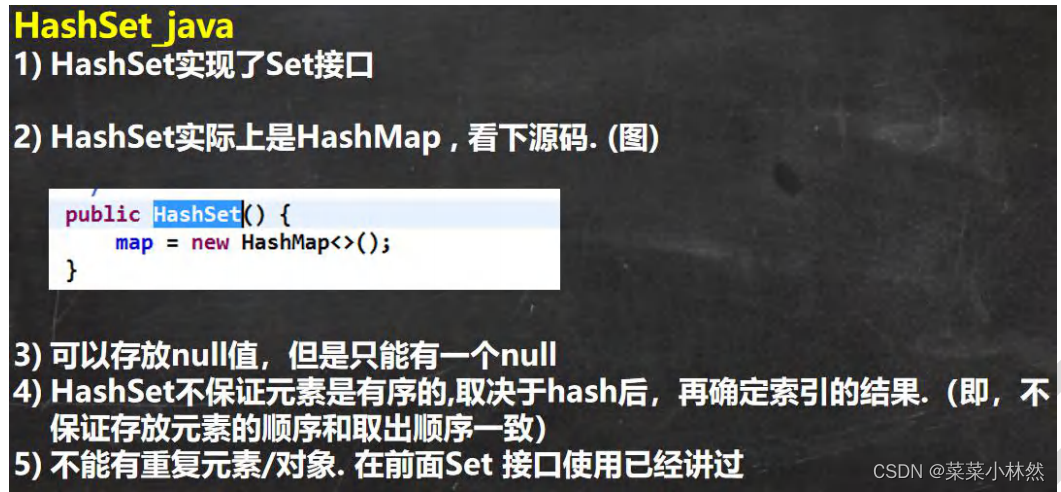
package com.hspedu.set_;
import java.util.HashSet;
import java.util.Set;
@SuppressWarnings({"all"})
public class HashSet_ {
public static void main(String[] args) {
//老韩解读
//1. 构造器走的源码
/*
public HashSet() {
map = new HashMap<>();
}
2. HashSet 可以存放null ,但是只能有一个null,即元素不能重复
*/
Set hashSet = new HashSet();
hashSet.add(null);
hashSet.add(null);
System.out.println("hashSet=" + hashSet);
}
}
2.2 HashSet 案例说明

package com.hspedu.set_;
import java.util.HashSet;
@SuppressWarnings({"all"})
public class HashSet01 {
public static void main(String[] args) {
HashSet set = new HashSet();
//说明
//1. 在执行add方法后,会返回一个boolean值
//2. 如果添加成功,返回 true, 否则返回false
//3. 可以通过 remove 指定删除哪个对象
System.out.println(set.add("john"));//T
System.out.println(set.add("lucy"));//T
System.out.println(set.add("john"));//F
System.out.println(set.add("jack"));//T
System.out.println(set.add("Rose"));//T
set.remove("john");
System.out.println("set=" + set);//3个
//
set = new HashSet();
System.out.println("set=" + set);//0
//4 Hashset 不能添加相同的元素/数据?
set.add("lucy");//添加成功
set.add("lucy");//加入不了
set.add(new Dog("tom"));//OK
set.add(new Dog("tom"));//Ok
System.out.println("set=" + set);
//在加深一下. 非常经典的面试题.
//看源码,做分析, 先给小伙伴留一个坑,以后讲完源码,你就了然
//去看他的源码,即 add 到底发生了什么?=> 底层机制.
set.add(new String("hsp"));//ok
set.add(new String("hsp"));//加入不了.
System.out.println("set=" + set);
}
}
class Dog { //定义了Dog类
private String name;
public Dog(String name) {
this.name = name;
}
@Override
public String toString() {
return "Dog{" +
"name='" + name + '\'' +
'}';
}
}
2.3 HashSet 底层机制说明


package com.hspedu.set_;
@SuppressWarnings({"all"})
public class HashSetStructure {
public static void main(String[] args) {
//模拟一个HashSet的底层 (HashMap 的底层结构)
//1. 创建一个数组,数组的类型是 Node[]
//2. 有些人,直接把 Node[] 数组称为 表
Node[] table = new Node[16];
//3. 创建结点
Node john = new Node("john", null);
table[2] = john;
Node jack = new Node("jack", null);
john.next = jack;// 将jack 结点挂载到john
Node rose = new Node("Rose", null);
jack.next = rose;// 将rose 结点挂载到jack
Node lucy = new Node("lucy", null);
table[3] = lucy; // 把lucy 放到 table表的索引为3的位置.
System.out.println("table=" + table);
}
}
class Node { //结点, 存储数据, 可以指向下一个结点,从而形成链表
Object item; //存放数据
Node next; // 指向下一个结点
public Node(Object item, Node next) {
this.item = item;
this.next = next;
}
}
【在这里我们可以看到他用得是equals,由于字符串改写了,其比较的是内容,之前的一个案例就在这里被解释了】
【如果table没到64,但是链表超过8,将会对table进行扩容】
【下面的源码更加说明了上面的结论】
package com.hspedu.set_;
import java.util.HashSet;
/**
* @author 韩顺平
* @version 1.0
*/
@SuppressWarnings({"all"})
public class HashSetSource {
public static void main(String[] args) {
HashSet hashSet = new HashSet();
hashSet.add("java");//到此位置,第1次add分析完毕.
hashSet.add("php");//到此位置,第2次add分析完毕
hashSet.add("java");
System.out.println("set=" + hashSet);
/*
对HashSet 的源码解读
1. 执行 HashSet()
public HashSet() {
map = new HashMap<>();
}
2. 执行 add()
public boolean add(E e) {//e = "java"
return map.put(e, PRESENT)==null;//(static) PRESENT = new Object();
}
3.执行 put() , 该方法会执行 hash(key) 得到key对应的hash值 算法h = key.hashCode()) ^ (h >>> 16)
public V put(K key, V value) {//key = "java" value = PRESENT 共享
return putVal(hash(key), key, value, false, true);
}
4.执行 putVal
final V putVal(int hash, K key, V value, boolean onlyIfAbsent,
boolean evict) {
Node<K,V>[] tab; Node<K,V> p; int n, i; //定义了辅助变量
//table 就是 HashMap 的一个数组,类型是 Node[]
//if 语句表示如果当前table 是null, 或者 大小=0
//就是第一次扩容,到16个空间.
if ((tab = table) == null || (n = tab.length) == 0)
n = (tab = resize()).length;
//(1)根据key,得到hash 去计算该key应该存放到table表的哪个索引位置
//并把这个位置的对象,赋给 p
//(2)判断p 是否为null
//(2.1) 如果p 为null, 表示还没有存放元素, 就创建一个Node (key="java",value=PRESENT)
//(2.2) 就放在该位置 tab[i] = newNode(hash, key, value, null)
if ((p = tab[i = (n - 1) & hash]) == null)
tab[i] = newNode(hash, key, value, null);
else {
//一个开发技巧提示: 在需要局部变量(辅助变量)时候,在创建
Node<K,V> e; K k; //
//如果当前索引位置对应的链表的第一个元素和准备添加的key的hash值一样
//并且满足 下面两个条件之一:
//(1) 准备加入的key 和 p 指向的Node 结点的 key 是同一个对象
//(2) p 指向的Node 结点的 key 的equals() 和准备加入的key比较后相同
//就不能加入
if (p.hash == hash &&
((k = p.key) == key || (key != null && key.equals(k))))
e = p;
//再判断 p 是不是一颗红黑树,
//如果是一颗红黑树,就调用 putTreeVal , 来进行添加
else if (p instanceof TreeNode)
e = ((TreeNode<K,V>)p).putTreeVal(this, tab, hash, key, value);
else {//如果table对应索引位置,已经是一个链表, 就使用for循环比较
//(1) 依次和该链表的每一个元素比较后,都不相同, 则加入到该链表的最后
// 注意在把元素添加到链表后,立即判断 该链表是否已经达到8个结点
// , 就调用 treeifyBin() 对当前这个链表进行树化(转成红黑树)
// 注意,在转成红黑树时,要进行判断, 判断条件
// if (tab == null || (n = tab.length) < MIN_TREEIFY_CAPACITY(64))
// resize();
// 如果上面条件成立,先table扩容.
// 只有上面条件不成立时,才进行转成红黑树
//(2) 依次和该链表的每一个元素比较过程中,如果有相同情况,就直接break
for (int binCount = 0; ; ++binCount) {
if ((e = p.next) == null) {
p.next = newNode(hash, key, value, null);
if (binCount >= TREEIFY_THRESHOLD(8) - 1) // -1 for 1st
treeifyBin(tab, hash);
break;
}
if (e.hash == hash &&
((k = e.key) == key || (key != null && key.equals(k))))
break;
p = e;
}
}
if (e != null) { // existing mapping for key
V oldValue = e.value;
if (!onlyIfAbsent || oldValue == null)
e.value = value;
afterNodeAccess(e);
return oldValue;
}
}
++modCount;
//size 就是我们每加入一个结点Node(k,v,h,next), size++
if (++size > threshold)
resize();//扩容
afterNodeInsertion(evict);
return null;
}
*/
}
}
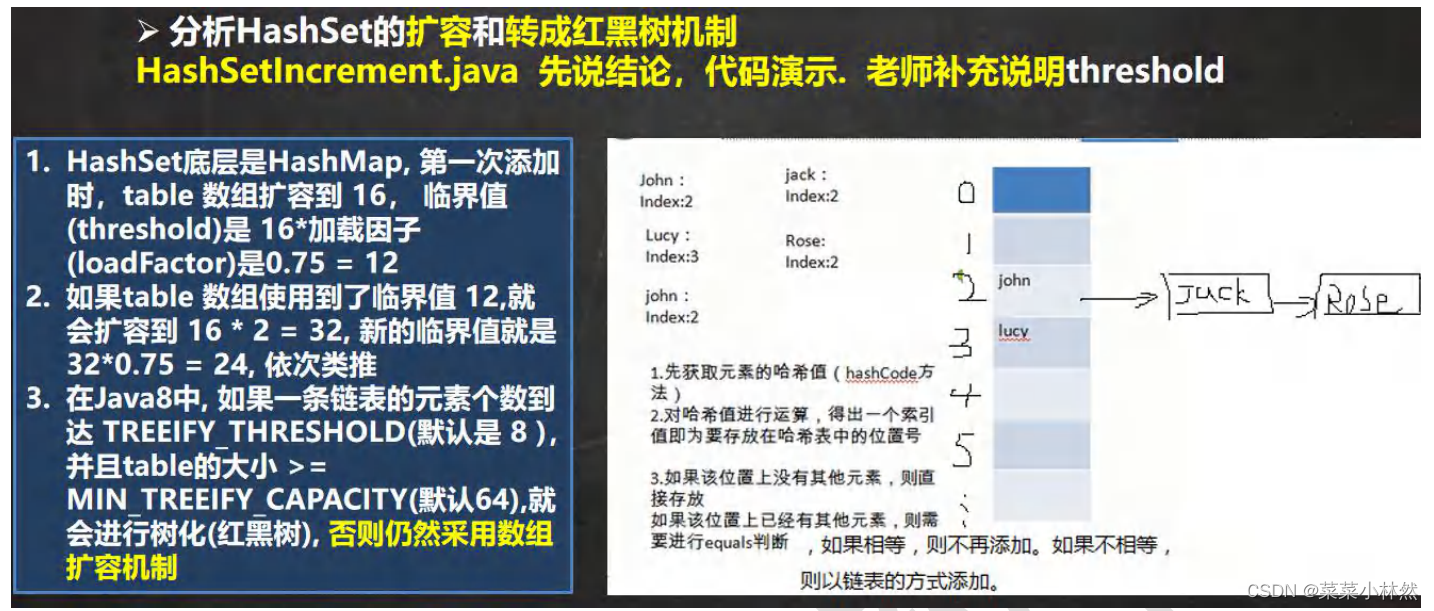
2.4 HashSet 课堂练习 1
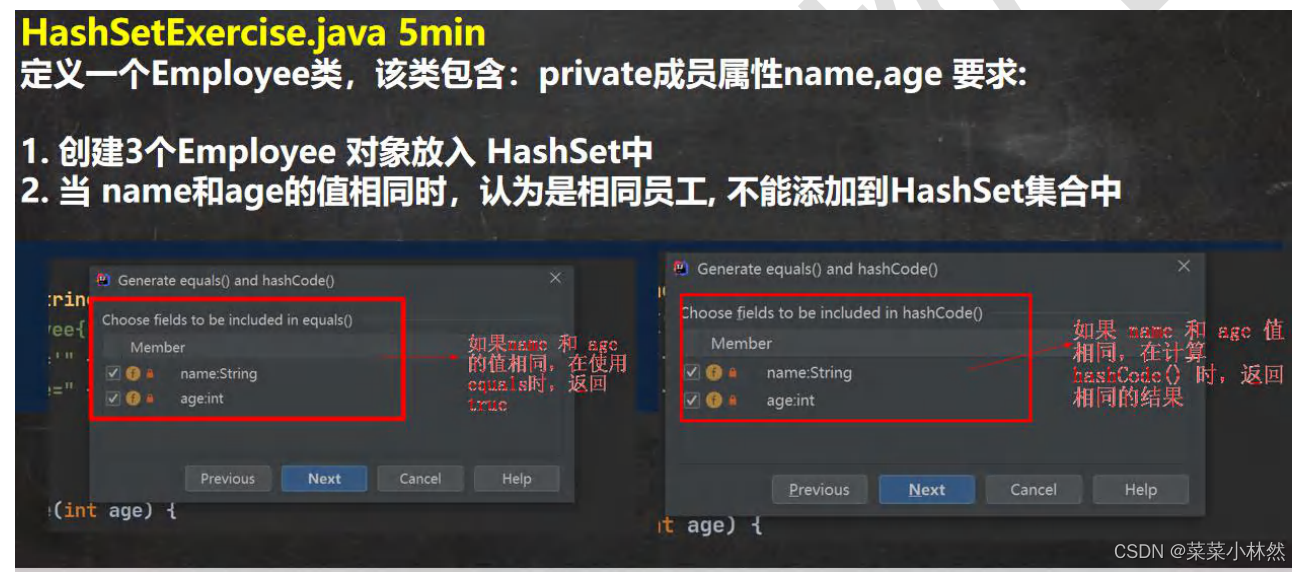
package com.hspedu.set_;
import java.util.HashSet;
import java.util.Objects;
/**
* @author 林然
* @version 1.0
*/
public class HashSetExercise {
@SuppressWarnings("all")
public static void main(String[] args) {
/**
定义一个 Employee 类,该类包含:private 成员属性 name,age 要求:
创建 3 个 Employee 对象放入 HashSet 中
当 name 和 age 的值相同时,认为是相同员工, 不能添加到 HashSet 集合中
*/
HashSet hashSet = new HashSet();
hashSet.add(new Employee("milan", 18));//ok
hashSet.add(new Employee("smith", 28));//ok
hashSet.add(new Employee("milan", 18));//加入不成功
System.out.println("hashSet=" + hashSet);
}
}
//创建 Employee
class Employee{
private String name;
private int age;
public Employee(String name, int age) {
this.name = name;
this.age = age;
}
public String getName() {
return name;
}
public void setName(String name) {
this.name = name;
}
public int getAge() {
return age;
}
public void setAge(int age) {
this.age = age;
}
@Override
public String toString() {
return "Employee{" +
"name='" + name + '\'' +
", age=" + age +
'}';
}
@Override
public boolean equals(Object o) {
if (this == o) return true;
if (o == null || getClass() != o.getClass()) return false;
Employee employee = (Employee) o;
return age == employee.age &&
Objects.equals(name, employee.name);
}
@Override
public int hashCode() {
return Objects.hash(name, age);
}
}
2.5 HashSet 课后练习 2

3.LinkedHashSet
3.1 LinkedHashSet 的全面说明
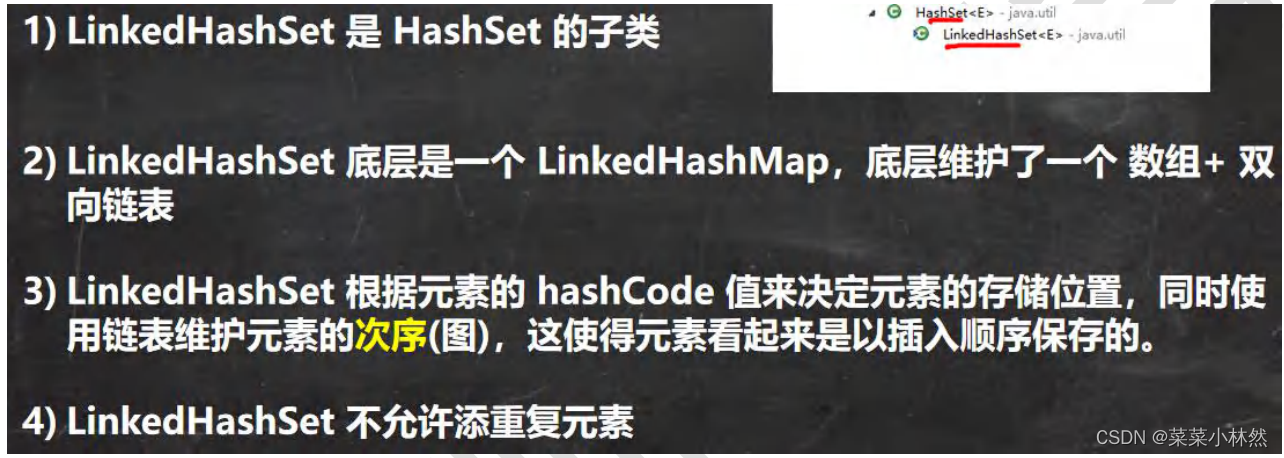
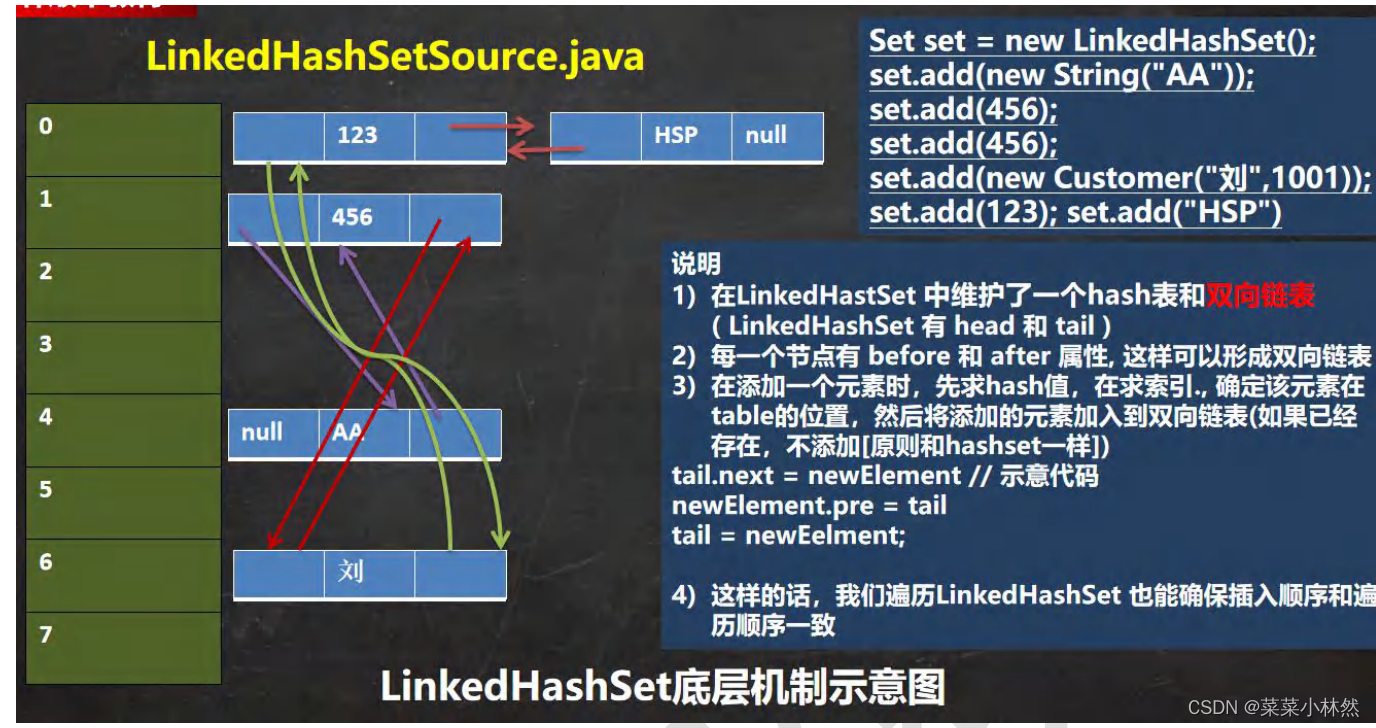
package com.hspedu.set_;
import java.util.LinkedHashSet;
import java.util.Set;
@SuppressWarnings({"all"})
public class LinkedHashSetSource {
public static void main(String[] args) {
//分析一下LinkedHashSet的底层机制
Set set = new LinkedHashSet();
set.add(new String("AA"));
set.add(456);
set.add(456);
set.add(new Customer("刘", 1001));
set.add(123);
set.add("HSP");
System.out.println("set=" + set);
//1. LinkedHashSet 加入顺序和取出元素/数据的顺序一致
//2. LinkedHashSet 底层维护的是一个LinkedHashMap(是HashMap的子类)
//3. LinkedHashSet 底层结构 (数组table+双向链表)
//4. 添加第一次时,直接将 数组table 扩容到 16 ,存放的结点类型是 LinkedHashMap$Entry
//5. 数组是 HashMap$Node[] 存放的元素/数据是 LinkedHashMap$Entry类型
/*
//继承关系是在内部类完成.
static class Entry<K,V> extends HashMap.Node<K,V> {
Entry<K,V> before, after;
Entry(int hash, K key, V value, Node<K,V> next) {
super(hash, key, value, next);
}
}
*/
}
}
class Customer {
private String name;
private int no;
public Customer(String name, int no) {
this.name = name;
this.no = no;
}
}
3.2 LinkedHashSet 课后练习题
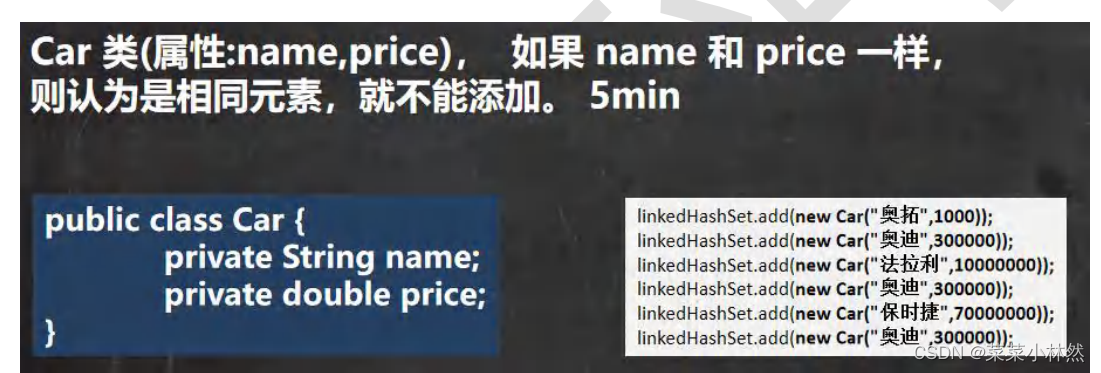
package com.hspedu.set_;
import java.util.LinkedHashSet;
import java.util.Objects;
@SuppressWarnings({"all"})
public class LinkedHashSetExercise {
public static void main(String[] args) {
LinkedHashSet linkedHashSet = new LinkedHashSet();
linkedHashSet.add(new Car("奥拓", 1000));//OK
linkedHashSet.add(new Car("奥迪", 300000));//OK
linkedHashSet.add(new Car("法拉利", 10000000));//OK
linkedHashSet.add(new Car("奥迪", 300000));//加入不了
linkedHashSet.add(new Car("保时捷", 70000000));//OK
linkedHashSet.add(new Car("奥迪", 300000));//加入不了
System.out.println("linkedHashSet=" + linkedHashSet);
}
}
/**
* Car 类(属性:name,price), 如果 name 和 price 一样,
* 则认为是相同元素,就不能添加。 5min
*/
class Car {
private String name;
private double price;
public Car(String name, double price) {
this.name = name;
this.price = price;
}
public String getName() {
return name;
}
public void setName(String name) {
this.name = name;
}
public double getPrice() {
return price;
}
public void setPrice(double price) {
this.price = price;
}
@Override
public String toString() {
return "\nCar{" +
"name='" + name + '\'' +
", price=" + price +
'}';
}
//重写equals 方法 和 hashCode
//当 name 和 price 相同时, 就返回相同的 hashCode 值, equals返回t
@Override
public boolean equals(Object o) {
if (this == o) return true;
if (o == null || getClass() != o.getClass()) return false;
Car car = (Car) o;
return Double.compare(car.price, price) == 0 &&
Objects.equals(name, car.name);
}
@Override
public int hashCode() {
return Objects.hash(name, price);
}
}四、Map
1.Map 接口和常用方法
1.1 Map 接口实现类的特点 [很实用]
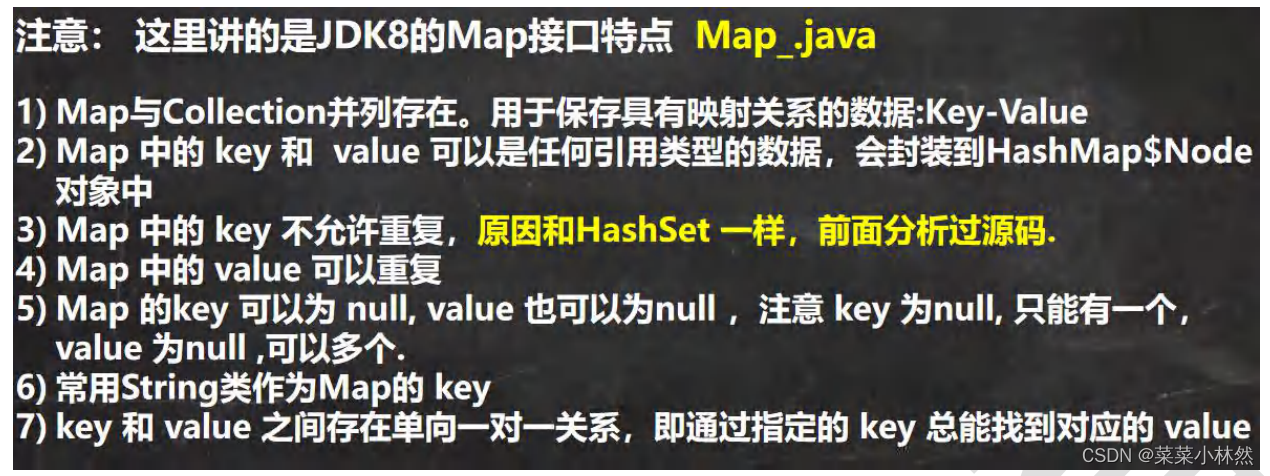
package com.hspedu.map_;
import java.util.HashMap;
import java.util.Map;
/**
* @author 林然
* @version 1.0
*/
public class Map_ {
@SuppressWarnings("all")
public static void main(String[] args) {
//老韩解读 Map 接口实现类的特点, 使用实现类 HashMap
//1. Map 与 Collection 并列存在。用于保存具有映射关系的数据:Key-Value(双列元素)
//2. Map 中的 key 和 value 可以是任何引用类型的数据,会封装到 HashMap$Node 对象中
//3. Map 中的 key 不允许重复,原因和 HashSet 一样,前面分析过源码. //4. Map 中的 value 可以重复
//5. Map 的 key 可以为 null, value 也可以为 null ,注意 key 为 null,
// 只能有一个,value 为 null ,可以多个
//6. 常用 String 类作为 Map 的 key
//7. key 和 value 之间存在单向一对一关系,即通过指定的 key 总能找到对应的 value
Map map =new HashMap();
map.put("no1","林然");//k-v
map.put("no2","林然2");//k-v
map.put("no1","张三丰");//k-v 当有相同的 k , 就等价于替换.
map.put("no3","张三丰");//k-v
map.put(null,null);//k-v
map.put(null,"abc");//k-v 当有相同的 k , 就等价于替换
map.put("no4",null);//k-v
map.put(1, "赵敏");//k-v
map.put(new Object(), "金毛狮王");//k-v
// 通过 get 方法,传入 key ,会返回对应的 value
System.out.println(map.get("no2"));//林然
System.out.println(map);
}
}
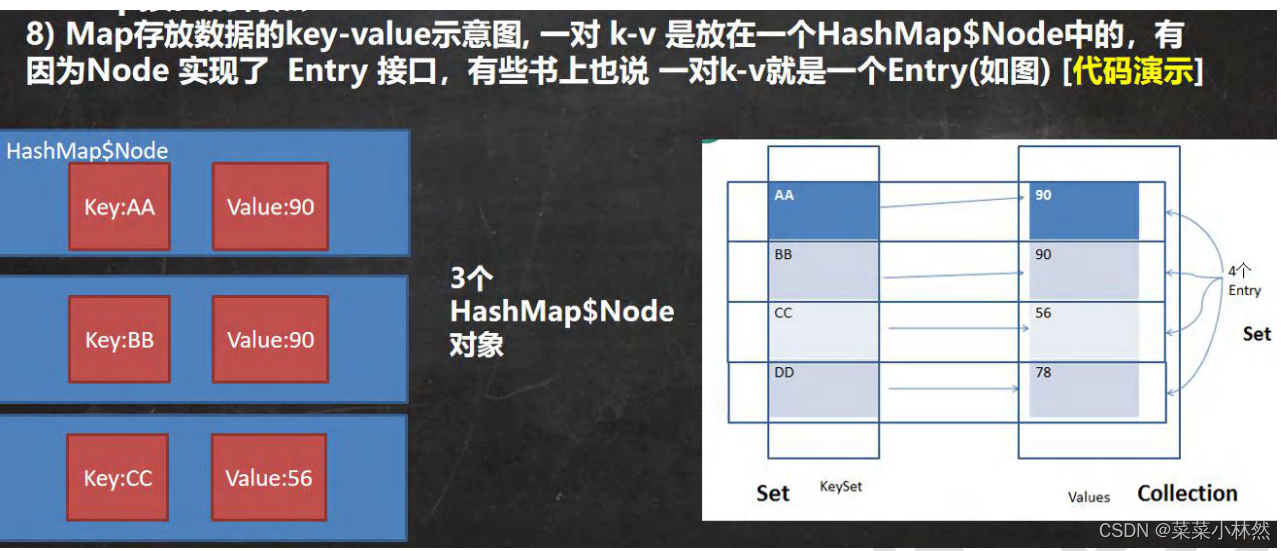
package com.hspedu.map_;
import java.util.Collection;
import java.util.HashMap;
import java.util.Map;
import java.util.Set;
@SuppressWarnings({"all"})
public class MapSource_ {
public static void main(String[] args) {
Map map = new HashMap();
map.put("no1", "韩顺平");//k-v
map.put("no2", "张无忌");//k-v
map.put(new Car(), new Person());//k-v
//老韩解读
//1. k-v 最后是 HashMap$Node node = newNode(hash, key, value, null)
//2. k-v 为了方便程序员的遍历,还会 创建 EntrySet 集合 ,该集合存放的元素的类型 Entry, 而一个Entry
// 对象就有k,v EntrySet<Entry<K,V>> 即: transient Set<Map.Entry<K,V>> entrySet;
//3. entrySet 中, 定义的类型是 Map.Entry ,但是实际上存放的还是 HashMap$Node
// 这时因为 static class Node<K,V> implements Map.Entry<K,V>
//4. 当把 HashMap$Node 对象 存放到 entrySet 就方便我们的遍历, 因为 Map.Entry 提供了重要方法
// K getKey(); V getValue();
Set set = map.entrySet();
System.out.println(set.getClass());// HashMap$EntrySet
for (Object obj : set) {
//System.out.println(obj.getClass()); //HashMap$Node
//为了从 HashMap$Node 取出k-v
//1. 先做一个向下转型
Map.Entry entry = (Map.Entry) obj;
System.out.println(entry.getKey() + "-" + entry.getValue() );
}
Set set1 = map.keySet();
System.out.println(set1.getClass());
Collection values = map.values();
System.out.println(values.getClass());
}
}
class Car {
}
class Person{
}
1.2 常用方法
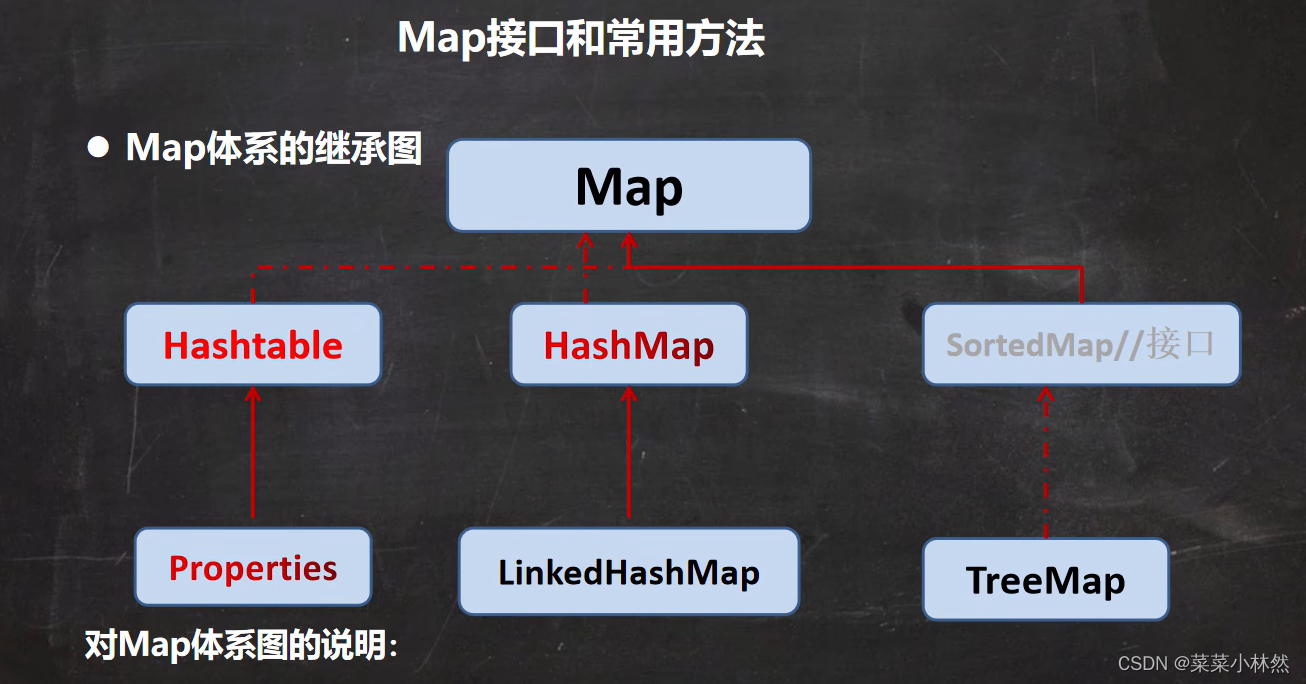
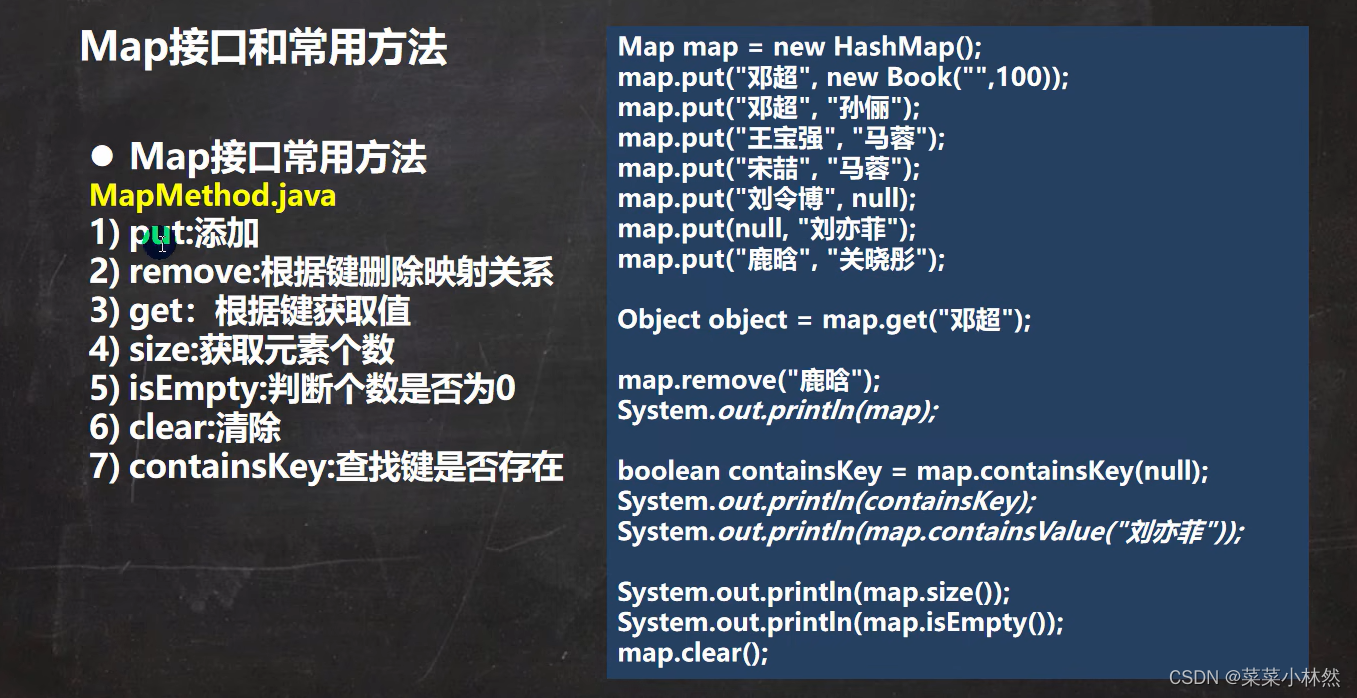
package com.hspedu.map_;
import java.util.HashMap;
import java.util.Map;
/**
* @author 林然
* @version 1.0
*/
public class MapMethod {
public static void main(String[] args) {
//演示 map 接口常用方法
Map map = new HashMap();
map.put("邓超", new Book("", 100));//OK
map.put("邓超", "孙俪");//替换-> 一会分析源码
map.put("王宝强", "马蓉");//OK
map.put("宋喆", "马蓉");//OK
map.put("刘令博", null);//OK
map.put(null, "刘亦菲");//OK
map.put("鹿晗", "关晓彤");//OK
map.put("hsp", "hsp 的老婆");
System.out.println("map=" + map);
// remove:根据键删除映射关系
map.remove(null);
System.out.println("map=" + map);
// get:根据键获取值
Object val = map.get("鹿晗");
System.out.println("val=" + val);
// size:获取元素个数
System.out.println("k-v=" + map.size());
// isEmpty:判断个数是否为 0
System.out.println(map.isEmpty());//F
// clear:清除 k-v
//map.clear();
System.out.println("map=" + map);
// containsKey:查找键是否存在
System.out.println("结果=" + map.containsKey("hsp"));//T
}
}
class Book {
private String name;
private int num;
public Book(String name, int num) {
this.name = name;
this.num = num;
}
}
1.3 Map 接口遍历方法
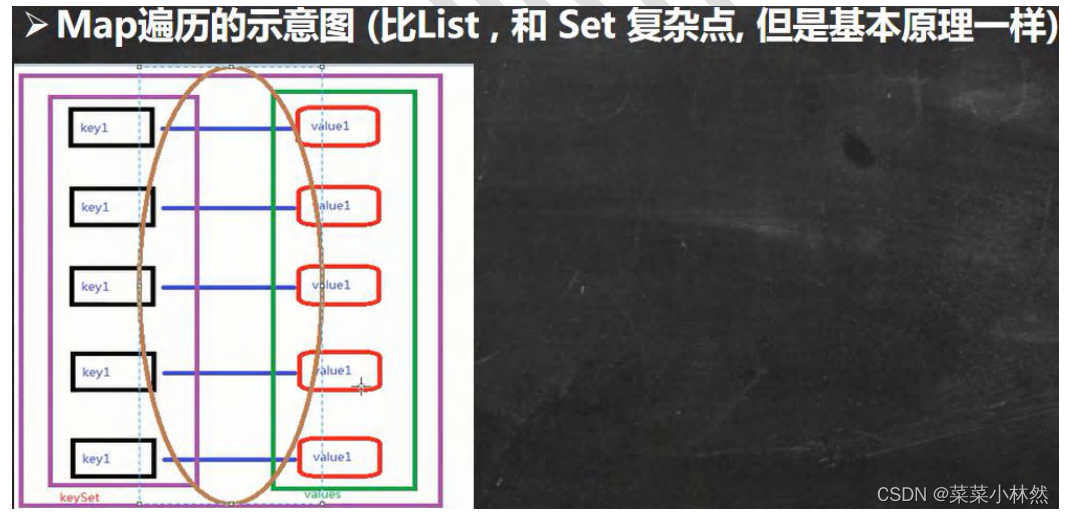
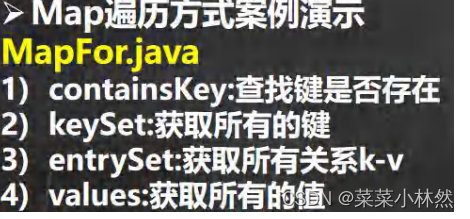
package com.hspedu.map_;
import java.util.*;
/**
* @author 林然
* @version 1.0
*/
@SuppressWarnings("all")
public class MapFor {
public static void main(String[] args) {
Map map = new HashMap();
map.put("邓超", "孙俪");
map.put("王宝强", "马蓉");
map.put("宋喆", "马蓉");
map.put("刘令博", null);
map.put(null, "刘亦菲");
map.put("鹿晗", "关晓彤");
//第一组: 先取出 所有的 Key , 通过 Key 取出对应的 Value
Set keyset = map.keySet();
//(1) 增强 for
System.out.println("-----第一种方式-------");
for (Object key : keyset) {
System.out.println(key + "-" + map.get(key));
}
//(2) 迭代器
System.out.println("----第二种方式--------");
Iterator iterator = keyset.iterator();
while (iterator.hasNext()) {
Object key = iterator.next();
System.out.println(key + "-" + map.get(key));
}
//第二组: 把所有的 values 取出
Collection values = map.values();
//这里可以使用所有的 Collections 使用的遍历方法
//(1) 增强 for
System.out.println("---取出所有的 value 增强 for----");
for (Object value : values) {
System.out.println(value);
}
//(2) 迭代器
System.out.println("---取出所有的 value 迭代器----");
Iterator iterator2 = values.iterator();
while (iterator2.hasNext()){
Object value = iterator2.next();
System.out.println(value);
}
//第三组: 通过 EntrySet 来获取 k-v
Set entrySet = map.entrySet();// EntrySet<Map.Entry<K,V>>
//(1) 增强 for
System.out.println("----使用 EntrySet 的 for 增强(第 3 种)----");
for (Object entry : entrySet) {
//将 entry 转成 Map.Entry
Map.Entry m = (Map.Entry) entry;
System.out.println(m.getKey() + "-" + m.getValue());
}
//(2) 迭代器
System.out.println("----使用 EntrySet 的 迭代器(第 4 种)----");
Iterator iterator3 = entrySet.iterator();
while (iterator3.hasNext()) {
Object entry = iterator3.next();
//System.out.println(next.getClass());//HashMap$Node -实现-> Map.Entry (getKey,getValue)
//向下转型 Map.Entry
Map.Entry m = (Map.Entry) entry;
System.out.println(m.getKey() + "-" + m.getValue());
}
}
}
1.4 Map 接口课堂练习
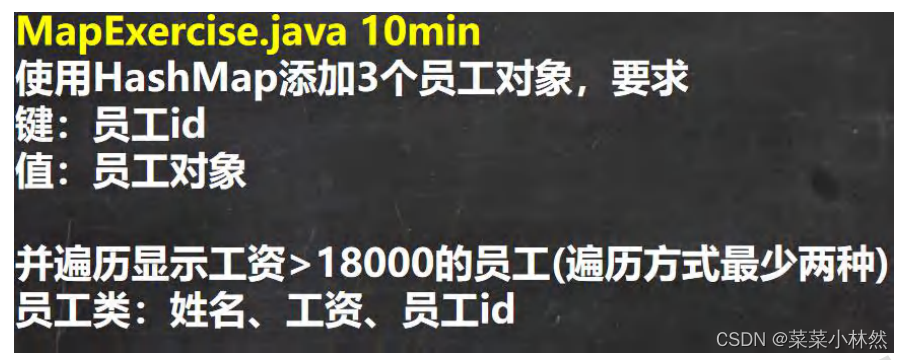
package com.hspedu.map_;
import java.util.HashMap;
import java.util.Iterator;
import java.util.Map;
import java.util.Set;
@SuppressWarnings({"all"})
public class MapExercise {
public static void main(String[] args) {
//完成代码
Map hashMap = new HashMap();
//添加对象
hashMap.put(1, new Emp("jack", 300000, 1));
hashMap.put(2, new Emp("tom", 21000, 2));
hashMap.put(3, new Emp("milan", 12000, 3));
//遍历2种方式
//并遍历显示工资>18000的员工(遍历方式最少两种)
//1. 使用keySet -> 增强for
Set keySet = hashMap.keySet();
System.out.println("====第一种遍历方式====");
for (Object key : keySet) {
//先获取value
Emp emp = (Emp) hashMap.get(key);
if(emp.getSal() >18000) {
System.out.println(emp);
}
}
//2. 使用EntrySet -> 迭代器
// 体现比较难的知识点
// 慢慢品,越品越有味道.
Set entrySet = hashMap.entrySet();
System.out.println("======迭代器======");
Iterator iterator = entrySet.iterator();
while (iterator.hasNext()) {
Map.Entry entry = (Map.Entry)iterator.next();
//通过entry 取得key 和 value
Emp emp = (Emp) entry.getValue();
if(emp.getSal() > 18000) {
System.out.println(emp);
}
}
}
}
/**
* 使用HashMap添加3个员工对象,要求
* 键:员工id
* 值:员工对象
*
* 并遍历显示工资>18000的员工(遍历方式最少两种)
* 员工类:姓名、工资、员工id
*/
class Emp {
private String name;
private double sal;
private int id;
public Emp(String name, double sal, int id) {
this.name = name;
this.sal = sal;
this.id = id;
}
public String getName() {
return name;
}
public void setName(String name) {
this.name = name;
}
public double getSal() {
return sal;
}
public void setSal(double sal) {
this.sal = sal;
}
public int getId() {
return id;
}
public void setId(int id) {
this.id = id;
}
@Override
public String toString() {
return "Emp{" +
"name='" + name + '\'' +
", sal=" + sal +
", id=" + id +
'}';
}
}
2.Map 接口实现类-HashMap
2.1 HashMap 小结

2.2 HashMap 底层机制及源码剖析
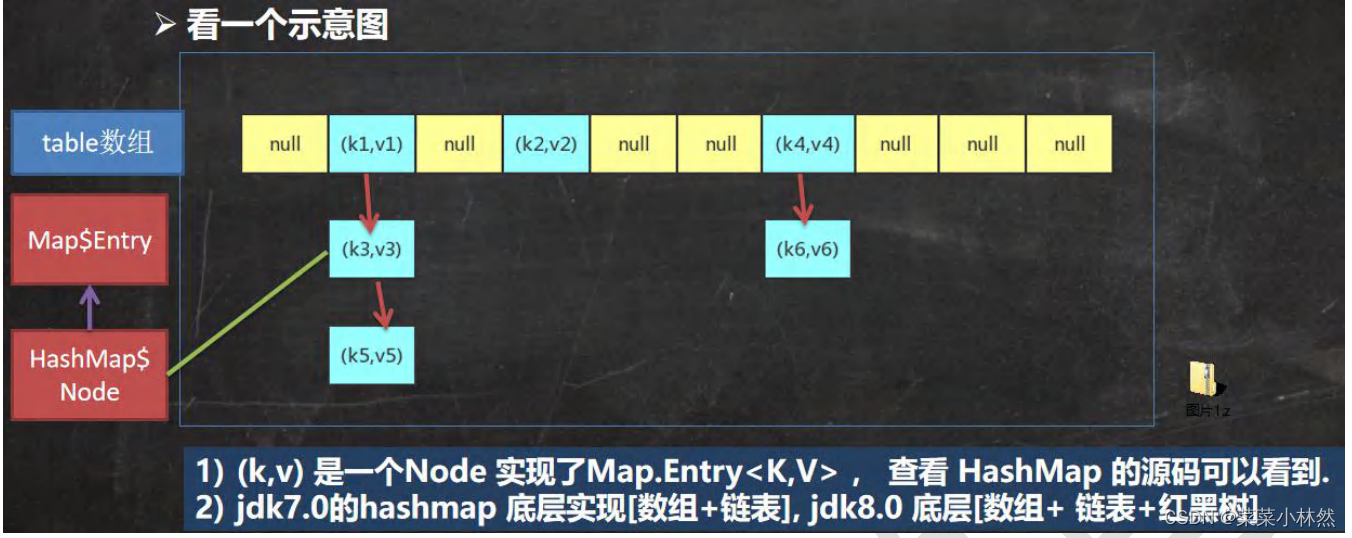
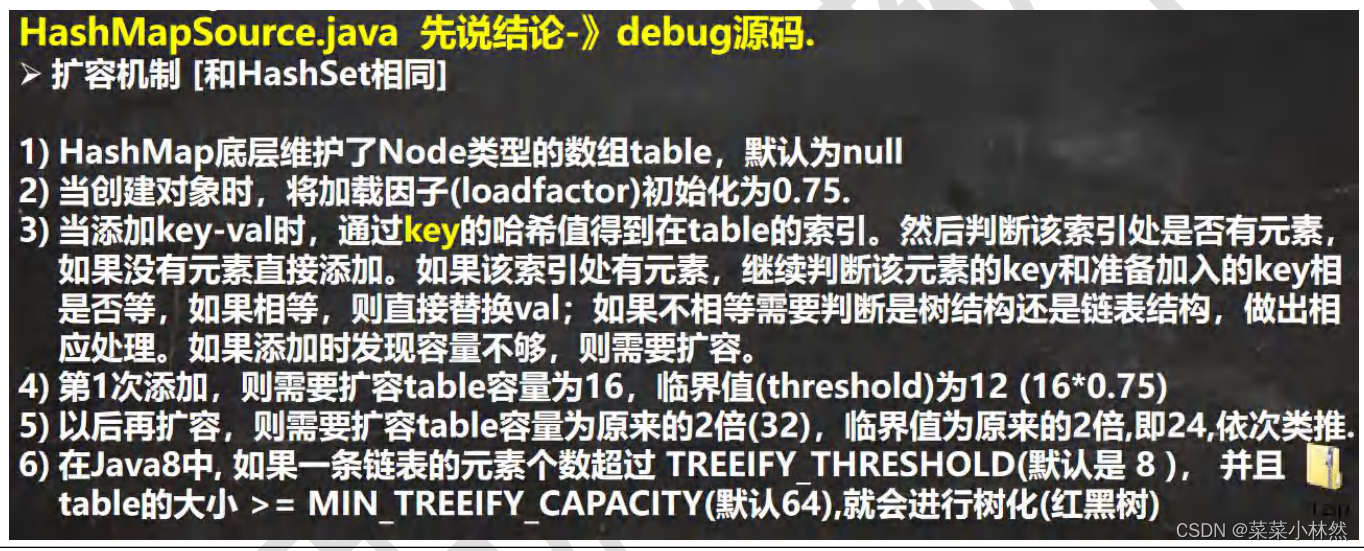
package com.hspedu.map_;
import java.util.HashMap;
@SuppressWarnings({"all"})
public class HashMapSource1 {
public static void main(String[] args) {
HashMap map = new HashMap();
map.put("java", 10);//ok
map.put("php", 10);//ok
map.put("java", 20);//替换value
System.out.println("map=" + map);//
/*老韩解读HashMap的源码+图解
1. 执行构造器 new HashMap()
初始化加载因子 loadfactor = 0.75
HashMap$Node[] table = null
2. 执行put 调用 hash方法,计算 key的 hash值 (h = key.hashCode()) ^ (h >>> 16)
public V put(K key, V value) {//K = "java" value = 10
return putVal(hash(key), key, value, false, true);
}
3. 执行 putVal
final V putVal(int hash, K key, V value, boolean onlyIfAbsent,
boolean evict) {
Node<K,V>[] tab; Node<K,V> p; int n, i;//辅助变量
//如果底层的table 数组为null, 或者 length =0 , 就扩容到16
if ((tab = table) == null || (n = tab.length) == 0)
n = (tab = resize()).length;
//取出hash值对应的table的索引位置的Node, 如果为null, 就直接把加入的k-v
//, 创建成一个 Node ,加入该位置即可
if ((p = tab[i = (n - 1) & hash]) == null)
tab[i] = newNode(hash, key, value, null);
else {
Node<K,V> e; K k;//辅助变量
// 如果table的索引位置的key的hash相同和新的key的hash值相同,
// 并 满足(table现有的结点的key和准备添加的key是同一个对象 || equals返回真)
// 就认为不能加入新的k-v
if (p.hash == hash &&
((k = p.key) == key || (key != null && key.equals(k))))
e = p;
else if (p instanceof TreeNode)//如果当前的table的已有的Node 是红黑树,就按照红黑树的方式处理
e = ((TreeNode<K,V>)p).putTreeVal(this, tab, hash, key, value);
else {
//如果找到的结点,后面是链表,就循环比较
for (int binCount = 0; ; ++binCount) {//死循环
if ((e = p.next) == null) {//如果整个链表,没有和他相同,就加到该链表的最后
p.next = newNode(hash, key, value, null);
//加入后,判断当前链表的个数,是否已经到8个,到8个,后
//就调用 treeifyBin 方法进行红黑树的转换
if (binCount >= TREEIFY_THRESHOLD - 1) // -1 for 1st
treeifyBin(tab, hash);
break;
}
if (e.hash == hash && //如果在循环比较过程中,发现有相同,就break,就只是替换value
((k = e.key) == key || (key != null && key.equals(k))))
break;
p = e;
}
}
if (e != null) { // existing mapping for key
V oldValue = e.value;
if (!onlyIfAbsent || oldValue == null)
e.value = value; //替换,key对应value
afterNodeAccess(e);
return oldValue;
}
}
++modCount;//每增加一个Node ,就size++
if (++size > threshold[12-24-48])//如size > 临界值,就扩容
resize();
afterNodeInsertion(evict);
return null;
}
5. 关于树化(转成红黑树)
//如果table 为null ,或者大小还没有到 64,暂时不树化,而是进行扩容.
//否则才会真正的树化 -> 剪枝
final void treeifyBin(Node<K,V>[] tab, int hash) {
int n, index; Node<K,V> e;
if (tab == null || (n = tab.length) < MIN_TREEIFY_CAPACITY)
resize();
}
*/
}
}
3.Map 接口实现类-Hashtable
3.1 HashTable 的基本介绍
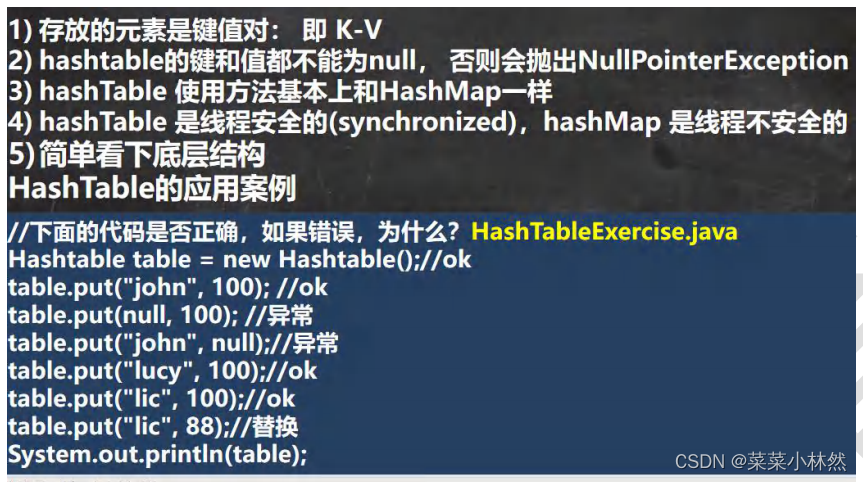 扩容【2倍+1】
扩容【2倍+1】
package com.hspedu.map_;
import java.util.Hashtable;
@SuppressWarnings({"all"})
public class HashTableExercise {
public static void main(String[] args) {
Hashtable table = new Hashtable();//ok
table.put("john", 100); //ok
//table.put(null, 100); //异常 NullPointerException
//table.put("john", null);//异常 NullPointerException
table.put("lucy", 100);//ok
table.put("lic", 100);//ok
table.put("lic", 88);//替换
table.put("hello1", 1);
table.put("hello2", 1);
table.put("hello3", 1);
table.put("hello4", 1);
table.put("hello5", 1);
table.put("hello6", 1);
System.out.println(table);
//简单说明一下Hashtable的底层
//1. 底层有数组 Hashtable$Entry[] 初始化大小为 11
//2. 临界值 threshold 8 = 11 * 0.75
//3. 扩容: 按照自己的扩容机制来进行即可.
//4. 执行 方法 addEntry(hash, key, value, index); 添加K-V 封装到Entry
//5. 当 if (count >= threshold) 满足时,就进行扩容
//5. 按照 int newCapacity = (oldCapacity << 1) + 1; 的大小扩容.
}
}
3.2 Hashtable 和 HashMap 对比

4.Map 接口实现类-Properties
4.1基本介绍

4.2 基本使用
package com.hspedu.map_;
import java.util.Properties;
/**
* @author Linran
* @version 1.0
*/
@SuppressWarnings({"all"})
public class Properties_ {
public static void main(String[] args) {
//老韩解读
//1. Properties 继承 Hashtable
//2. 可以通过 k-v 存放数据,当然key 和 value 不能为 null
//增加
Properties properties = new Properties();
//properties.put(null, "abc");//抛出 空指针异常
//properties.put("abc", null); //抛出 空指针异常
properties.put("john", 100);//k-v
properties.put("lucy", 100);
properties.put("lic", 100);
properties.put("lic", 88);//如果有相同的key , value被替换
System.out.println("properties=" + properties);
//通过k 获取对应值
System.out.println(properties.get("lic"));//88
//删除
properties.remove("lic");
System.out.println("properties=" + properties);
//修改
properties.put("john", "约翰");
System.out.println("properties=" + properties);
}
}
五、总结-开发中如何选择集合实现类(记住)

5.1TreeSet源码解读
package com.hspedu.set_;
import java.util.Comparator;
import java.util.TreeSet;
/**
* @author 林然
* @version 1.0
*/
@SuppressWarnings({"all"})
public class TreeSet_ {
public static void main(String[] args) {
//1. 当我们使用无参构造器,创建TreeSet时,仍然是无序的
//2. 老师希望添加的元素,按照字符串大小来排序
//3. 使用TreeSet 提供的一个构造器,可以传入一个比较器(匿名内部类)
// 并指定排序规则
//4. 简单看看源码
/*
1. 构造器把传入的比较器对象,赋给了 TreeSet的底层的 TreeMap的属性this.comparator
public TreeMap(Comparator<? super K> comparator) {
this.comparator = comparator;
}
2. 在 调用 treeSet.add("tom"), 在底层会执行到
if (cpr != null) {//cpr 就是我们的匿名内部类(对象)
do {
parent = t;
//动态绑定到我们的匿名内部类(对象)compare
cmp = cpr.compare(key, t.key);
if (cmp < 0)
t = t.left;
else if (cmp > 0)
t = t.right;
else //如果相等,即返回0,这个Key就没有加入
return t.setValue(value);
} while (t != null);
}
*/
// TreeSet treeSet = new TreeSet();
TreeSet treeSet = new TreeSet(new Comparator() {
@Override
public int compare(Object o1, Object o2) {
//下面 调用String的 compareTo方法进行字符串大小比较
//如果老韩要求加入的元素,按照长度大小排序
//return ((String) o2).compareTo((String) o1);
return ((String) o1).length() - ((String) o2).length();
}
});
//添加数据.
treeSet.add("jack");
treeSet.add("tom");//3
treeSet.add("sp");
treeSet.add("a");
treeSet.add("abc");//3,并不会加入
System.out.println("treeSet=" + treeSet);
}
}
5.2 TreeMap源码解读
package com.hspedu.map_;
import java.util.Comparator;
import java.util.TreeMap;
/**
* @author 林然
* @version 1.0
*/
@SuppressWarnings({"all"})
public class TreeMap_ {
public static void main(String[] args) {
//使用默认的构造器,创建TreeMap, 是无序的(也没有排序)
/*
老韩要求:按照传入的 k(String) 的大小进行排序
*/
// TreeMap treeMap = new TreeMap();
TreeMap treeMap = new TreeMap(new Comparator() {
@Override
public int compare(Object o1, Object o2) {
//按照传入的 k(String) 的大小进行排序
//按照K(String) 的长度大小排序
//return ((String) o2).compareTo((String) o1);
return ((String) o2).length() - ((String) o1).length();
}
});
treeMap.put("jack", "杰克");
treeMap.put("tom", "汤姆");
treeMap.put("kristina", "克瑞斯提诺");
treeMap.put("smith", "斯密斯");
treeMap.put("hsp", "韩顺平");//加入不了,会把汤姆修改成韩顺平
System.out.println("treemap=" + treeMap);
/*
老韩解读源码:
1. 构造器. 把传入的实现了 Comparator接口的匿名内部类(对象),传给给TreeMap的comparator
public TreeMap(Comparator<? super K> comparator) {
this.comparator = comparator;
}
2. 调用put方法
2.1 第一次添加, 把k-v 封装到 Entry对象,放入root
Entry<K,V> t = root;
if (t == null) {
compare(key, key); // type (and possibly null) check
root = new Entry<>(key, value, null);
size = 1;
modCount++;
return null;
}
2.2 以后添加
Comparator<? super K> cpr = comparator;
if (cpr != null) {
do { //遍历所有的key , 给当前key找到适当位置
parent = t;
cmp = cpr.compare(key, t.key);//动态绑定到我们的匿名内部类的compare
if (cmp < 0)
t = t.left;
else if (cmp > 0)
t = t.right;
else //如果遍历过程中,发现准备添加Key 和当前已有的Key 相等,就不添加
return t.setValue(value);
} while (t != null);
}
*/
}
}
六、Collections 工具类
1 Collections 工具类介绍

2 排序操作:(均为 static 方法)

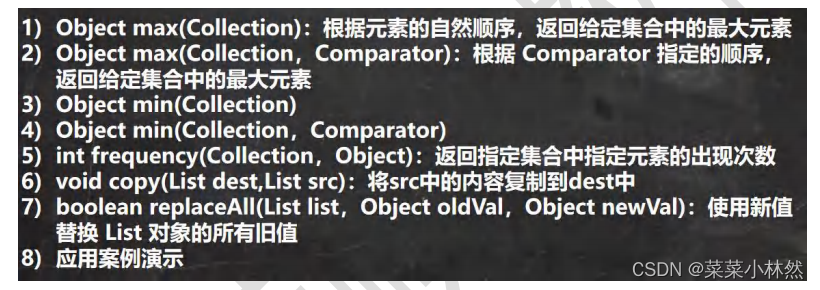
package com.hspedu.collections_;
import java.util.*;
/**
* @author 林然
* @version 1.0
*/
@SuppressWarnings("all")
public class Collections_ {
public static void main(String[] args) {
//创建 ArrayList 集合,用于测试.
List list = new ArrayList();
list.add("tom");
list.add("smith");
list.add("king");
list.add("milan");
list.add("tom");
// reverse(List):反转 List 中元素的顺序
Collections.reverse(list);
System.out.println(list);
// shuffle(List):对 List 集合元素进行随机排序
// for (int i = 0; i < 5; i++) {
// Collections.shuffle(list);
// System.out.println("list=" + list);
//sort(List):根据元素的自然顺序对指定 List 集合元素按升序排序
Collections.sort(list);
System.out.println("自然排序后");
System.out.println("list=" + list);//按照首字母进行排序
// sort(List,Comparator):根据指定的 Comparator 产生的顺序对 List 集合元素进行排序
//我们希望按照 字符串的长度大小排序
Collections.sort(list, new Comparator() {
@Override
public int compare(Object o1, Object o2) {
//可以加入校验代码.
return ((String) o2).length() - ((String) o1).length();
}
});
System.out.println("字符串长度大小排序=" + list);
// swap(List,int, int):将指定 list 集合中的 i 处元素和 j 处元素进行交换
//比如
Collections.swap(list, 0, 1);
System.out.println("交换后的情况");
System.out.println("list=" + list);
//Object max(Collection):根据元素的自然顺序,返回给定集合中的最大元素
System.out.println("自然顺序最大元素=" + Collections.max(list));
//Object max(Collection,Comparator):根据 Comparator 指定的顺序,返回给定集合中的最大元素
//比如,我们要返回长度最大的元素
Object maxObject = Collections.max(list, new Comparator() {
@Override
public int compare(Object o1, Object o2) {
return ((String)o1).length() - ((String)o2).length();
}
});
System.out.println("长度最大的元素=" + maxObject);
//Object min(Collection)
//Object min(Collection,Comparator)
//上面的两个方法,参考 max 即可
//int frequency(Collection,Object):返回指定集合中指定元素的出现次数
System.out.println("tom 出现的次数=" + Collections.frequency(list, "tom"));
//void copy(List dest,List src):将 src 中的内容复制到 dest 中
ArrayList dest = new ArrayList();
//为了完成一个完整拷贝,我们需要先给 dest 赋值,大小和 list.size()一样
for(int i = 0; i < list.size(); i++) {
dest.add("");
}
//拷贝
Collections.copy(dest, list);
System.out.println("dest=" + dest);
//boolean replaceAll(List list,Object oldVal,Object newVal):使用新值替换 List 对象的所有旧值
//如果 list 中,有 tom 就替换成 汤姆
Collections.replaceAll(list, "tom", "汤姆");
System.out.println("list 替换后=" + list);
}
}
七、本章作业
1.作业一

package com.hspedu.homework;
import java.util.ArrayList;
import java.util.Collections;
/**
* @author 林然
* @version 1.0
*/
@SuppressWarnings("all")
public class homework1 {
public static void main(String[] args) {
News1 new1=new News1("新冠确诊病例超千万,数百万印度教信徒赴恒河\"圣浴\"引民众担忧");
News1 new2=new News1("男子突然想起2个月前钓的鱼还在网兜里,捞起一看赶紧放生");
ArrayList arrayList =new ArrayList();
arrayList.add(new1);
arrayList.add(new2);
Collections.reverse(arrayList);
for (Object k:arrayList) {
News1 k1 = (News1)k;
if(k1.getTitle().length()>=15)
System.out.println(k1.getTitle().substring(0, 15) + "...");
else
System.out.println(k1.getTitle());
}
}
}
class News1{
private String title;
private String content;
public News1(String title) {
this.title = title;
}
public String getTitle() {
return title;
}
public void setTitle(String title) {
this.title = title;
}
public String getContent() {
return content;
}
public void setContent(String content) {
this.content = content;
}
@Override
public String toString() {
return "News{" +
"title='" + title + '\'' +
", content='" + content + '\'' +
'}';
}
}
2.作业二
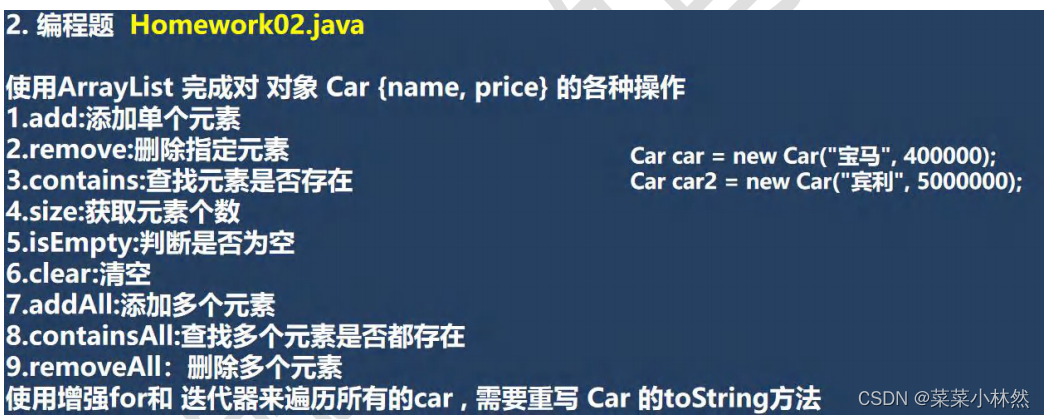
package com.hspedu.homework;
import java.util.ArrayList;
import java.util.Iterator;
@SuppressWarnings({"all"})
public class Homework02 {
public static void main(String[] args) {
ArrayList arrayList = new ArrayList();
Car car = new Car("宝马", 400000);
Car car2 = new Car("宾利",5000000);
//1.add:添加单个元素
arrayList.add(car);
arrayList.add(car2);
System.out.println(arrayList);
//* 2.remove:删除指定元素
arrayList.remove(car);
System.out.println(arrayList);
//* 3.contains:查找元素是否存在
System.out.println(arrayList.contains(car));//F
//* 4.size:获取元素个数
System.out.println(arrayList.size());//1
//* 5.isEmpty:判断是否为空
System.out.println(arrayList.isEmpty());//F
//* 6.clear:清空
//System.out.println(arrayList.clear(););
//* 7.addAll:添加多个元素
System.out.println(arrayList);
arrayList.addAll(arrayList);//2个宾利
System.out.println(arrayList);
//* 8.containsAll:查找多个元素是否都存在
arrayList.containsAll(arrayList);//T
//* 9.removeAll:删除多个元素
//arrayList.removeAll(arrayList); //相当于清空
//* 使用增强for和 迭代器来遍历所有的car , 需要重写 Car 的toString方法
for (Object o : arrayList) {
System.out.println(o);//
}
System.out.println("===迭代器===");
Iterator iterator = arrayList.iterator();
while (iterator.hasNext()) {
Object next = iterator.next();
System.out.println(next);
}
}
}
/**
* 使用ArrayList 完成对 对象 Car {name, price} 的各种操作
* 1.add:添加单个元素
* 2.remove:删除指定元素
* 3.contains:查找元素是否存在
* 4.size:获取元素个数
* 5.isEmpty:判断是否为空
* 6.clear:清空
* 7.addAll:添加多个元素
* 8.containsAll:查找多个元素是否都存在
* 9.removeAll:删除多个元素
* 使用增强for和 迭代器来遍历所有的car , 需要重写 Car 的toString方法
*/
class Car {
private String name;
private double price;
public Car(String name, double price) {
this.name = name;
this.price = price;
}
public String getName() {
return name;
}
public void setName(String name) {
this.name = name;
}
public double getPrice() {
return price;
}
public void setPrice(double price) {
this.price = price;
}
@Override
public String toString() {
return "Car{" +
"name='" + name + '\'' +
", price=" + price +
'}';
}
}
3.作业三

package com.hspedu.homework;
import java.util.*;
/**
* @author 林然
* @version 1.0
*/
public class homework3 {
@SuppressWarnings("all")
public static void main(String[] args) {
Map m = new HashMap();
m.put("jack",650);
m.put("tom",1200);
m.put("smith",2900);
m.replace("jack",2600);
Set keys =m.keySet();
//更新工资
for(Object k :keys)
{ int salary=(int)(m.get(k));
m.replace(k,salary+100);
}
//遍历集合中的员工
//遍历 EntrySet
Set entrySet = m.entrySet();
//迭代器
Iterator iterator = entrySet.iterator();
while (iterator.hasNext()) {
Map.Entry entry = (Map.Entry)iterator.next();
System.out.println(entry.getKey() + "-" + entry.getValue());
}
System.out.println("====遍历所有的工资====");
Collection values = m.values();
for (Object value : values) {
System.out.println("工资=" + value);
}
}
}
4.作业四

5.作业五

//package com.hspedu.homework;
//
//import java.util.TreeSet;
//
//@SuppressWarnings({"all"})
//public class Homework05 {
// public static void main(String[] args) {
// TreeSet treeSet = new TreeSet();
// //分析源码
// //add 方法,因为 TreeSet() 构造器没有传入Comparator接口的匿名内部类
// //所以在底层 Comparable<? super K> k = (Comparable<? super K>) key;
// //即 把 Perosn转成 Comparable类型
// treeSet.add(new Person());//ClassCastException.
// treeSet.add(new Person());//ClassCastException.
// treeSet.add(new Person());//ClassCastException.
// treeSet.add(new Person());//ClassCastException.
// treeSet.add(new Person());//ClassCastException.
//
// System.out.println(treeSet);
//
// }
//}
//
//class Person implements Comparable{
//
// @Override
// public int compareTo(Object o) {
// return 0;
// }
//}
6.作业六
【只要id和name不一样,那么我们认为他们不是同一个对象】
【remove中是利用1001和CC来计算哈希值,也就是他没办法找到p1所在的位置【1001+AA】】
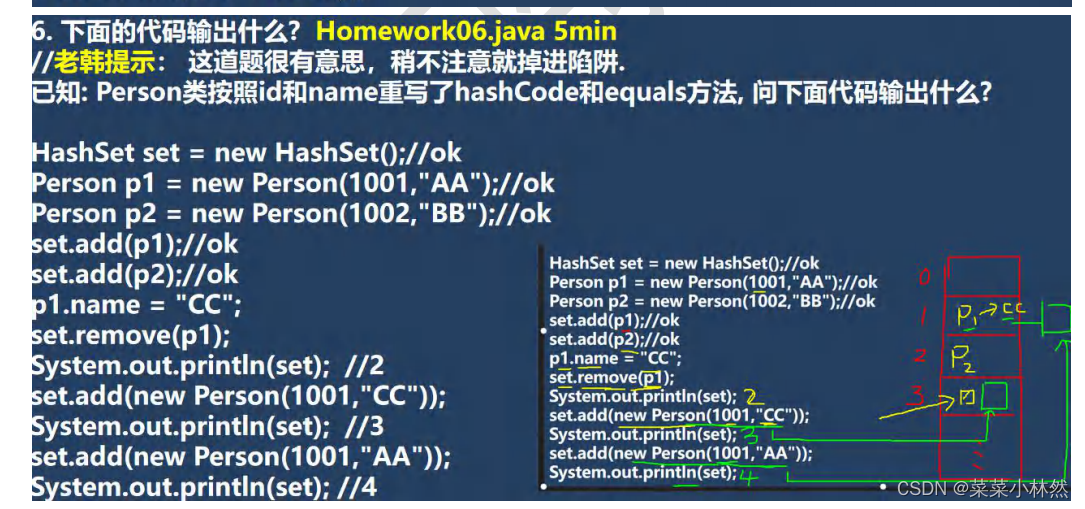
package com.hspedu.homework;
import java.util.HashSet;
import java.util.Objects;
@SuppressWarnings({"all"})
public class Homework06 {
public static void main(String[] args) {
HashSet set = new HashSet();//ok
Person p1 = new Person(1001,"AA");//ok
Person p2 = new Person(1002,"BB");//ok
set.add(p1);//ok
set.add(p2);//ok
p1.name = "CC";
set.remove(p1);
System.out.println(set);//2
set.add(new Person(1001,"CC"));
System.out.println(set);//3
set.add(new Person(1001,"AA"));
System.out.println(set);//4
}
}
class Person {
public String name;
public int id;
public Person(int id, String name) {
this.name = name;
this.id = id;
}
@Override
public boolean equals(Object o) {
if (this == o) return true;
if (o == null || getClass() != o.getClass()) return false;
Person person = (Person) o;
return id == person.id &&
Objects.equals(name, person.name);
}
@Override
public int hashCode() {
return Objects.hash(name, id);
}
@Override
public String toString() {
return "Person{" +
"name='" + name + '\'' +
", id=" + id +
'}';
}
}
7.作业七
